I would have never thought in my life that the inshore delivery of a sailing yacht (without rigging) would come out this exciting! No, believe me, it´s something very, very different from sailing in the matter we understand it, but in many cases travelling inshore with a boat over rivers and canals may hold some very nice surprises for you and your crew and will certainly open up a whole new world for sailors. Here´s what I´ve done so far …

As you may have read in my Inshore Delivery article part 1 (read it here, if not) I´ve started right at the location of my company´s winter storage facilities in Muenster, a town that may be described as situated “well inland” of Germany. Nevertheless, at least at the beginning of the industrialization period of Germany and Europe some two Centuries ago, Germany acquired a pretty awesome network of well-maintained canals and inwater-trade routes. Some of which I will discover over the duration of my inshore delivery.

And here we are: I´ve boarded a brand new Beneteau Oceanis 35.1 which had been sold just days before the season stared and was briefed to deliver the boat by means of her own power to the new customers at the Baltic Sea. We´ve had the mast not stepped yet because bridges inland in Germany only allow for an air-draft of max 4.50 metres – so the engine had to propel us. And it did quite well. For me as a skipper this trip opened up some pretty new perspectives and was a very exciting trip as well, although completely different from what I had done before.
A whole new perspective on sailing a boat
First of all, you change as a sailor when travelling inshore. That said, “all” you have to do is to steer the boat well free from the angular shore within the some 35 metres wide canals. As they are mostly man-made structures there is no currents so steering-wise it´s not very exciting. On the other hand, the experience of nature is whole different thing: It´s just amazing!
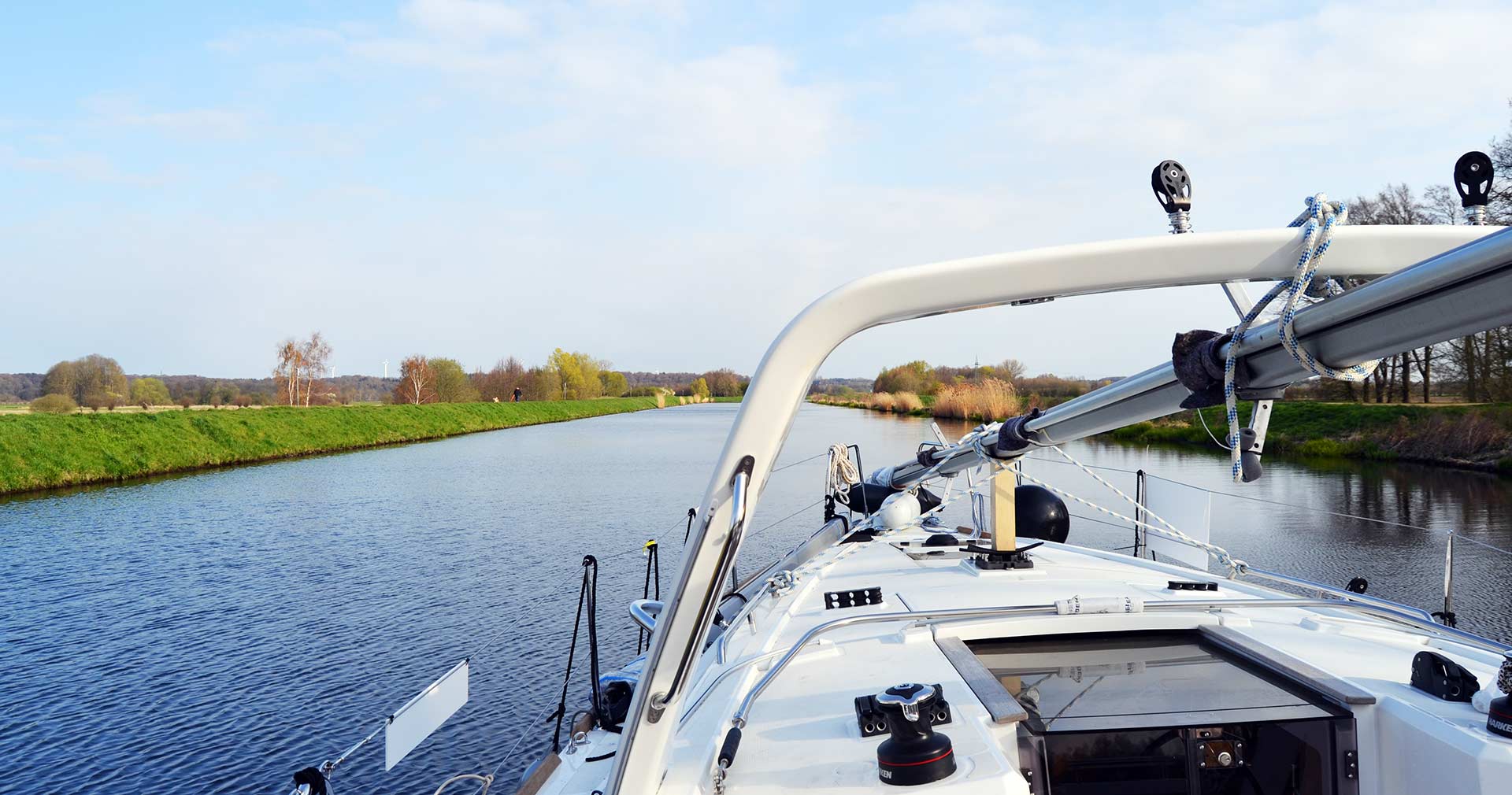
I remember that right at the beginning of the trip in Hannover, I remember passing by an industrial building of Continental tyres, a structure I know very well from driving on the Autobahn. But seen from the canal, I couldn´t even hear the cars and the hustle on the street, I was passing the exact same building on a ship on water and was framed by lush green trees and strolling people with their dogs! Unbelievable. Also, the quietness, the forests, the fields and meadows … it´s just an amazing view on the countryside.
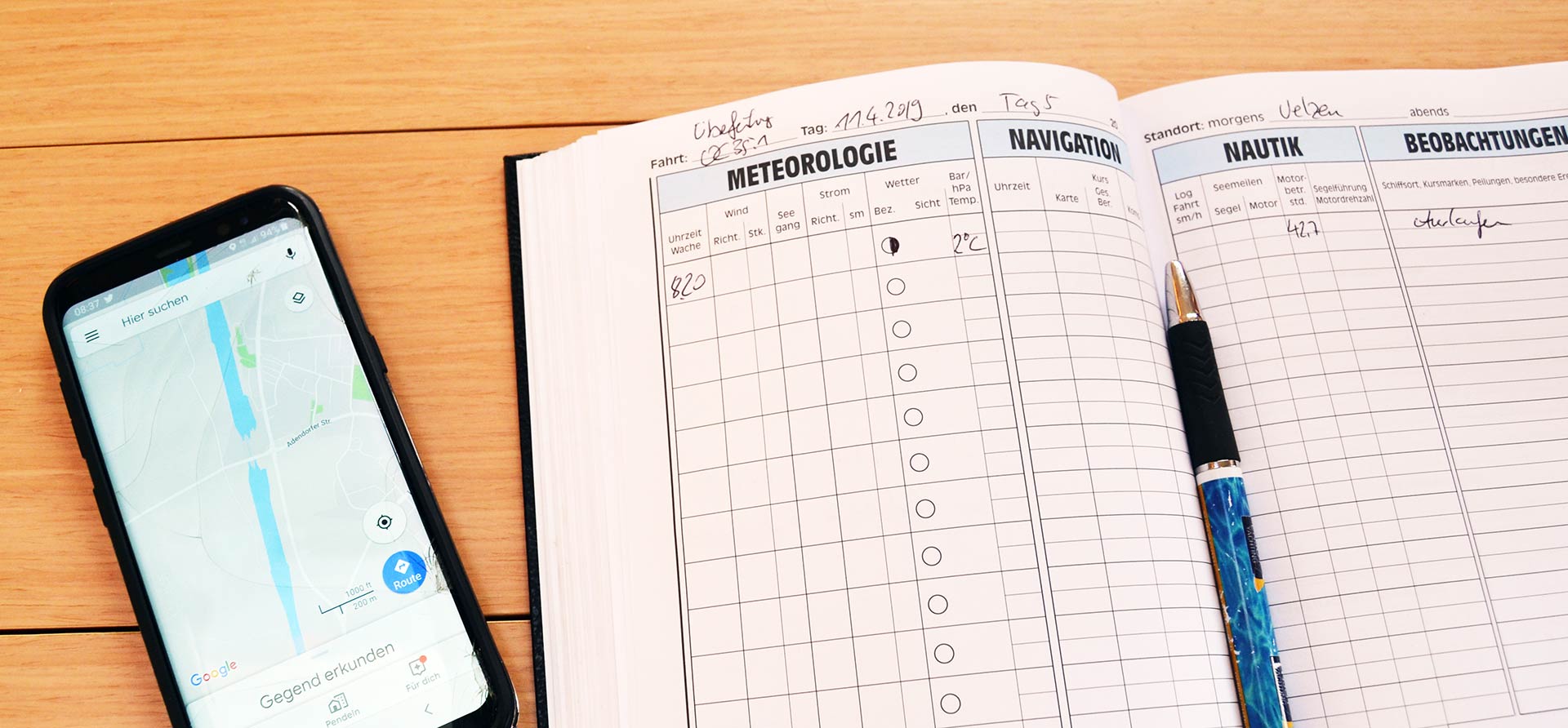
Nevertheless, I never ceased to be a proper skipper. Right when the day started I began a new page in the logbook by checking oil, engine, bilge and stuff and I also took notes of every change of the watch, the locks and other events.
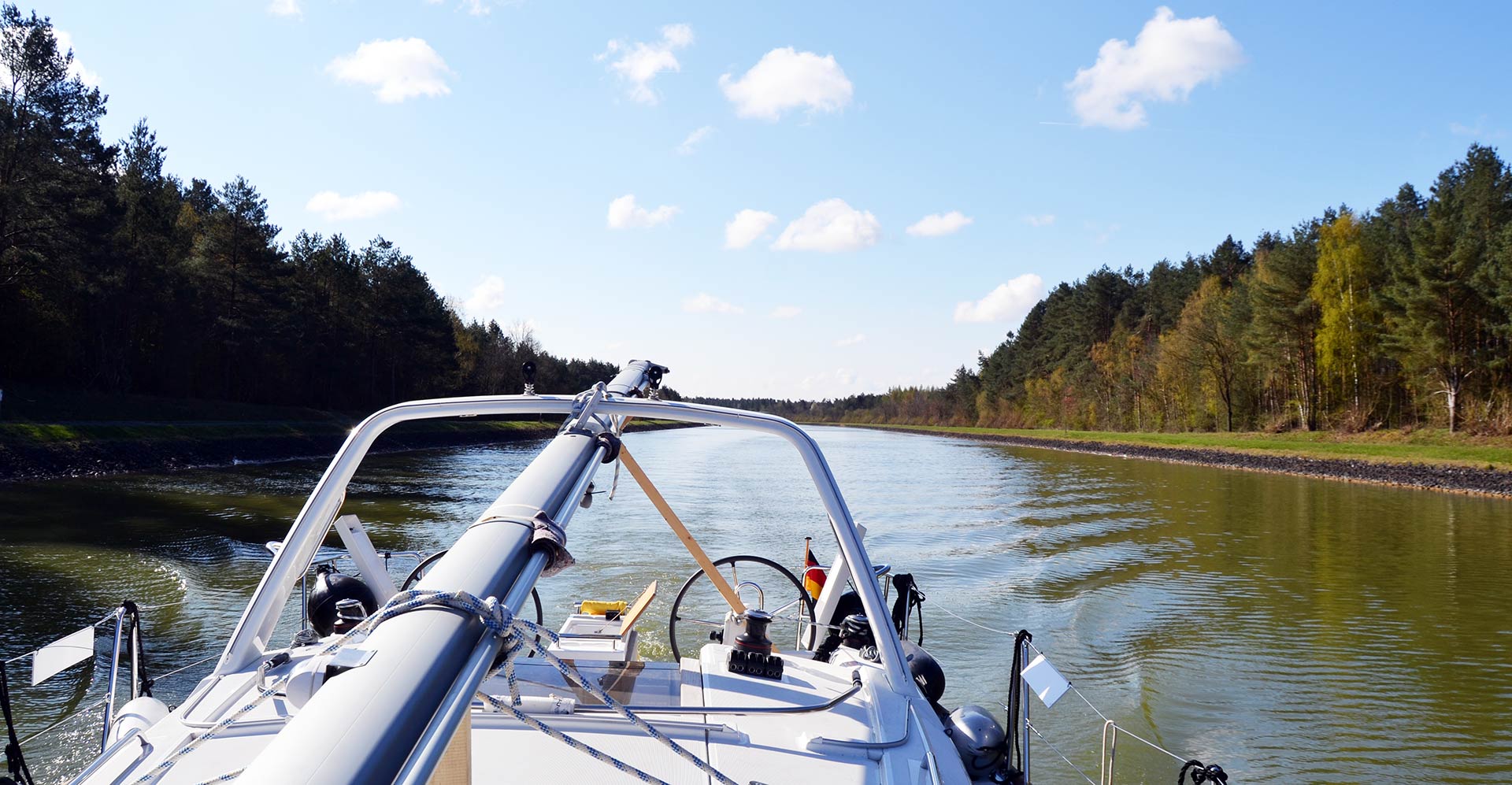
But all in all it really was a nice and smooth start into the sailing season of this year: Slowly but surely our boat made her way up North. It´s permitted to go faster than 10 kilometres per hour on German inshore waterways (but they do, obviously), so I dashed along with 6.4 knots max and found may way from the Dortmund-Ems-Canal to the Mittelland-Channel, crossing into the, as they call it here, “Heide Suez” Canal, which is officially named Elbe-Side-Canal with a brief visit to mighty River Elbe by fast jumping into the picturesque Elbe-Luebek-Canal which will eventually lead into the Baltic Sea – the upcoming Part 3 of this series.
Are Inland Water Vessels hazardous?
This Part 2 is mainly dedicated to the locks and lifts all along the waterways and how we tackled it. But first some brief words to good seamanship in relation to meeting the commercial shipping on the inland canals. There are so many stories about some kind of “war” going on between Captains of inland water vessels and pleasure craft skippers, horror-stories on brutal pushing aside the small boats, of harsh overtaking and hollering going on. Well, my opinion and my experience is a completely different one: I´ve never ever seen a Captain of a vessel behaving like this. Never, ever! And I must say, all of them greeted, all of them smiled and not a single one was causing me headache.
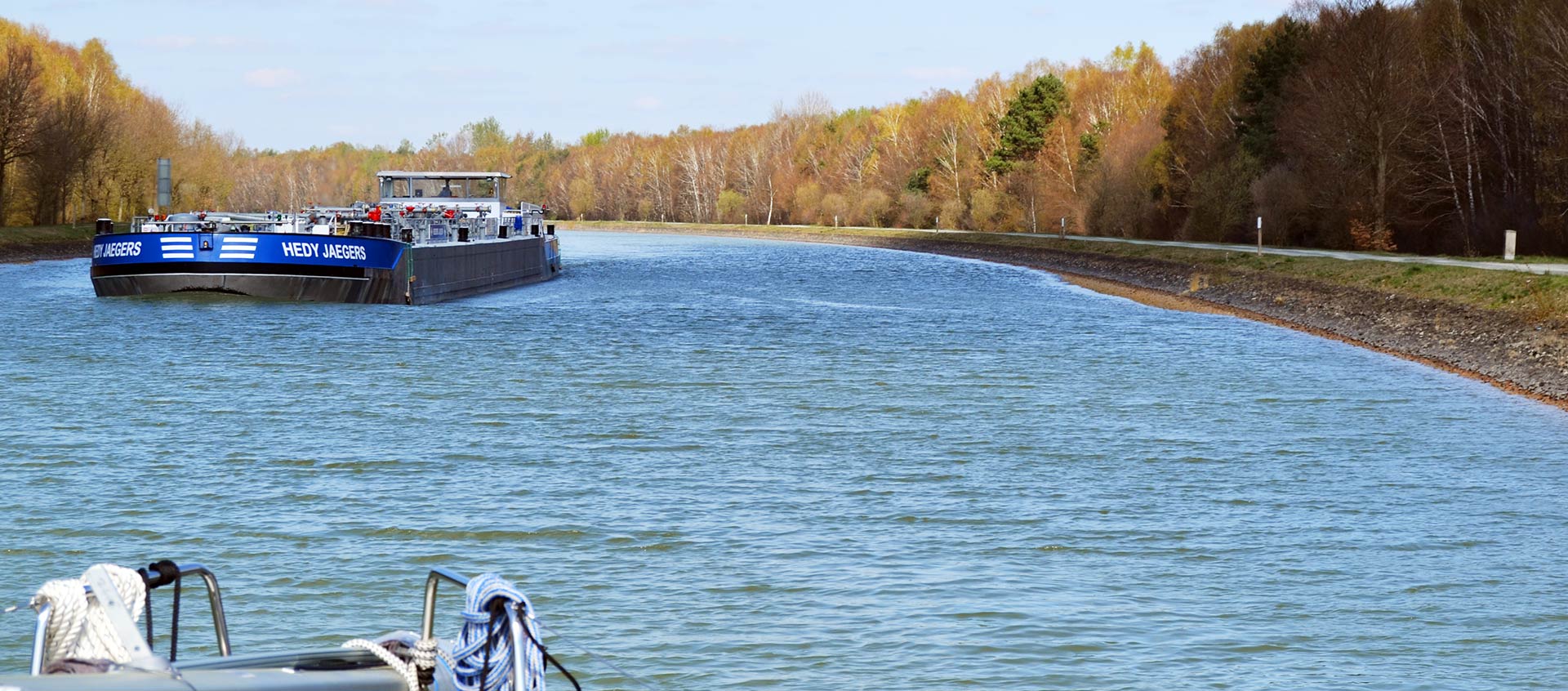
Well, what was causing me some headache, I must admit, was this fascinating physics of canels and large inland water vessels. As you may as well observe on my pictures taken, the bulky ships seem to be pushing a “mountain” of water just with their bows. That said, the are also dragging a valley of shallow water right amidships. It was a kind of frightening view when I mastered the passing of the first ships because one can clearly see that water level is falling 1 meter and more right behind the bow of such a ship!
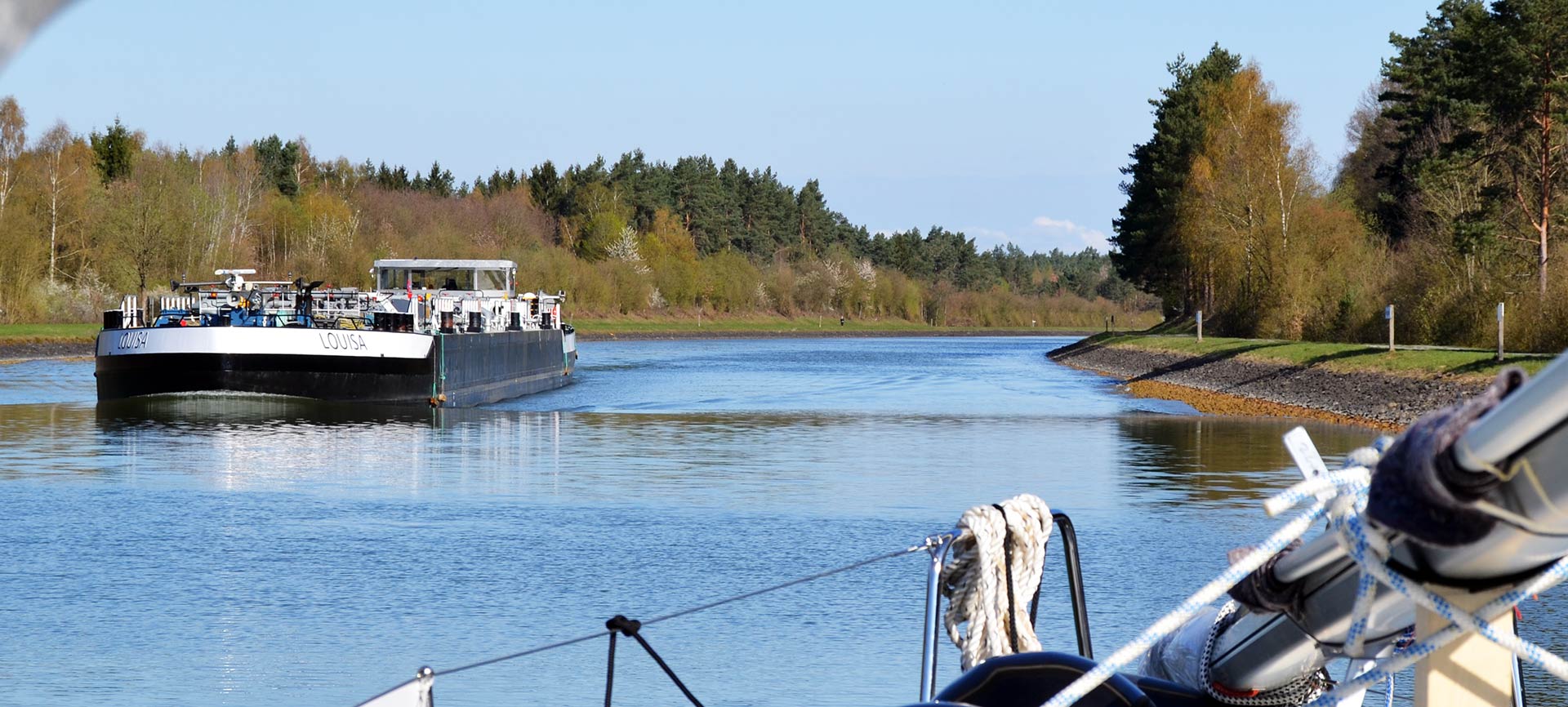
So, how to tackle a meeting with a large, bulky inland water vessel? Well, it is looking far more serious than it is in reality. First, I was keeping to the right side of the channel as best as I could. Most of German channels maintain a width of 35 metres so when there´s enough room for two vessels meeting there should be more than enough room for me. When I passed the “mountain” of the bow wash, I felt the boat sail down into the valley and felt a slight suction towards the ship passing. Knowing that, a little bit of counter-rudder corrected my course and I never felt any danger at all. When the ships passed, I immediately steered into their stern-wake which I used to get an extra-push by their screws, sometimes speeding up the boat to 7 knots!
Mastering Canal Locks
Now, the fun part begins. Locks! Along my way I was to pass no less than 10 locks. Well, 9 locks and one ship´s lift, to be precisely, which I will take on later in full detail. First of all – no fear for locks. It´s fun and it´s always very exciting to go either up or down. In fact, it´s a fascinating technical thing and again such an old-fashioned by nevertheless so well-thought through technique that I was looking forward so much to all these locks. But there are some rules you might consider.
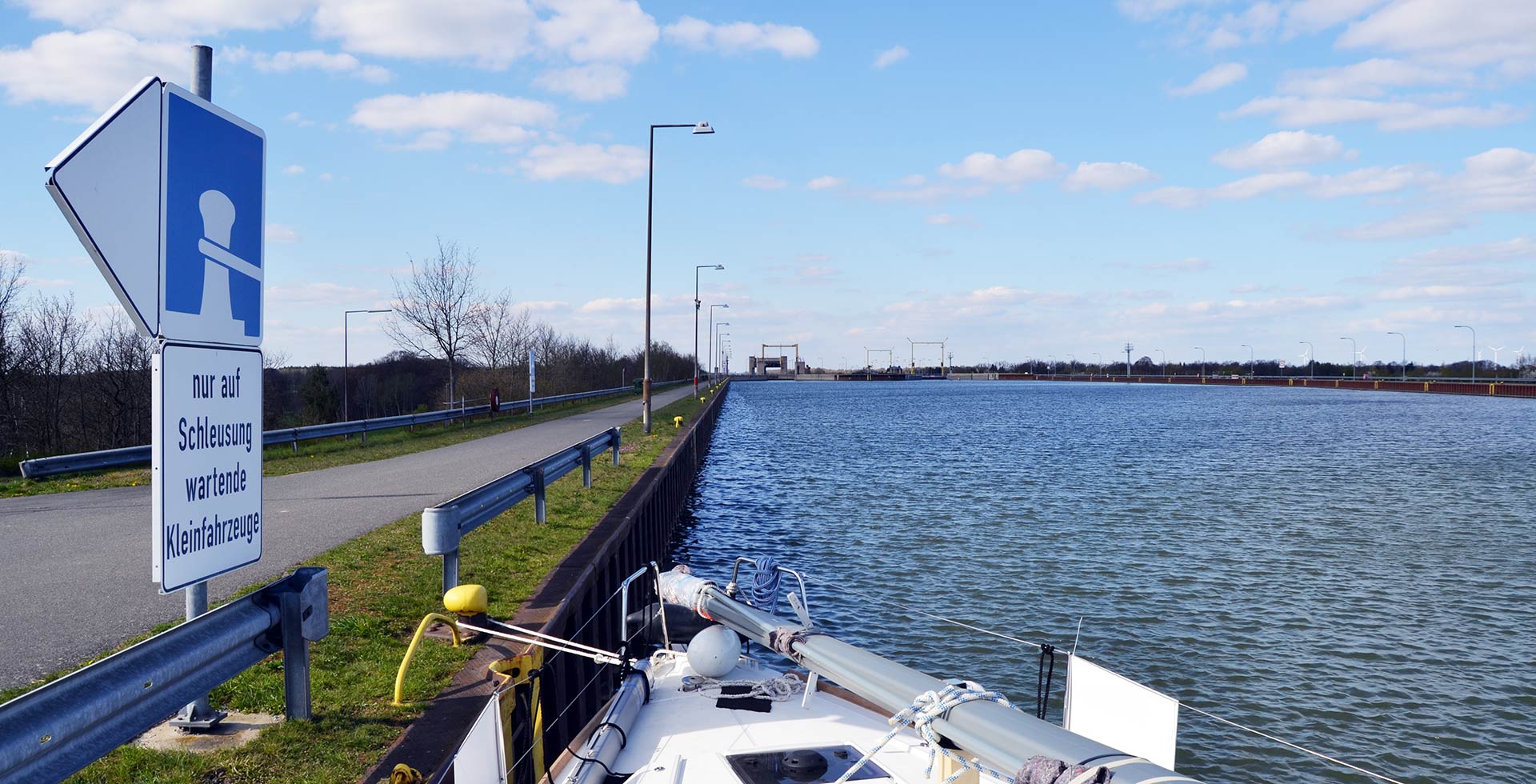
First of all: These locks are manned by people and as such they are serious business. You should plan your trip well ahead in a way that you have the phone numbers of the locks or the VHF-channel in your notes. Upon nearing, mostly when I had the structure well in sight at half a mile or so, I would call the lock master by phone (with rigging down there simply wasn´t any chance to use the VHF). Most of the time the personnel ordered my boat to wait.
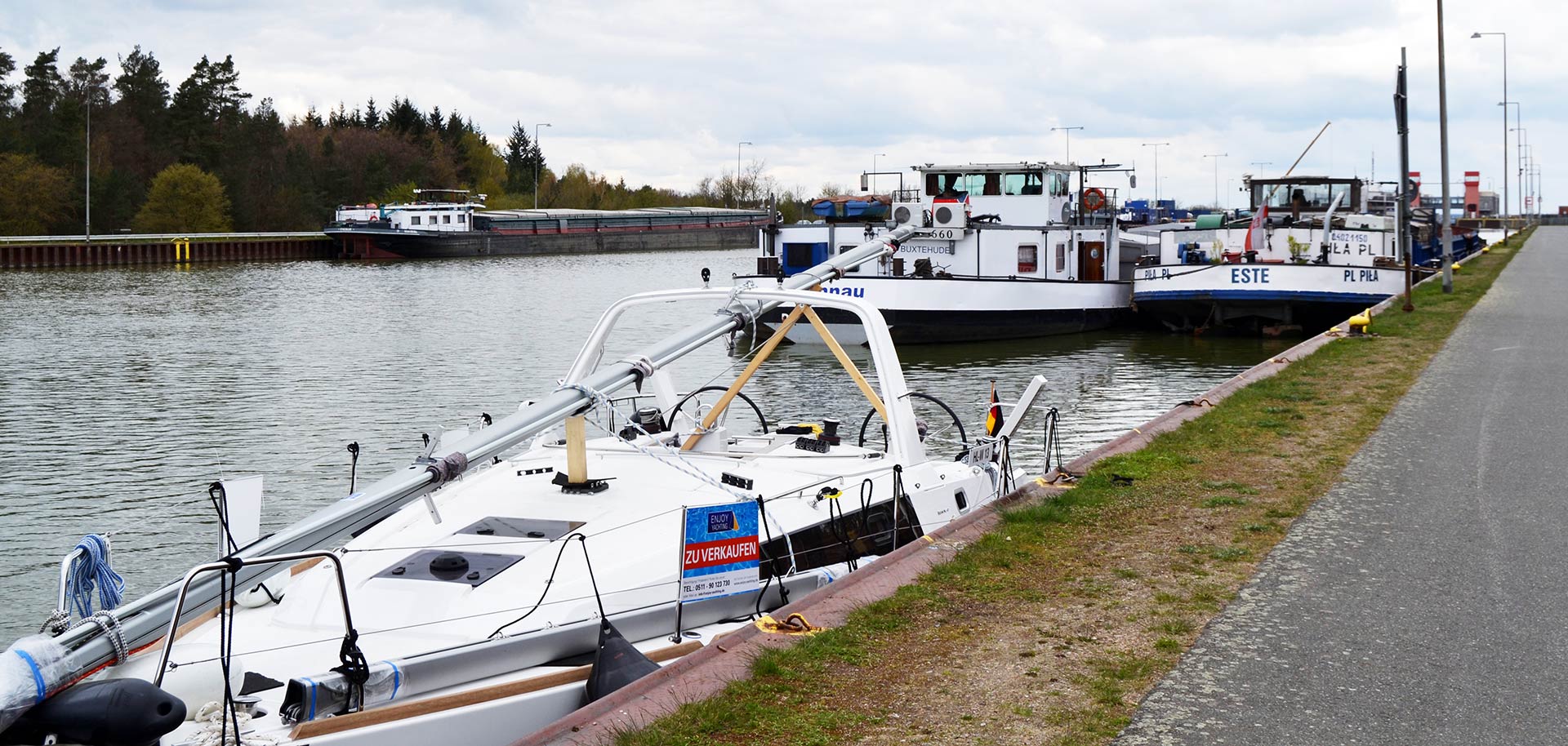
There are designated waiting areas for pleasure craft before the locks, mostly behind the commercial traffic which in every way has the right of way and will always be first in and out of a ship´s lock. So you bring your boat alongside, tie her up and stop the engine. Sometimes the lock master would tell me the approximate waiting time, sometimes he would give me the name of the commercial ship that was due to go in first. Some locks have large loudspeakers which will announce when the lock is open for pleasure craft. In any way: Don´t leave the ship and be ready to cast off at a moment´s notice – because you are a guest and for commercial shipping time is money.
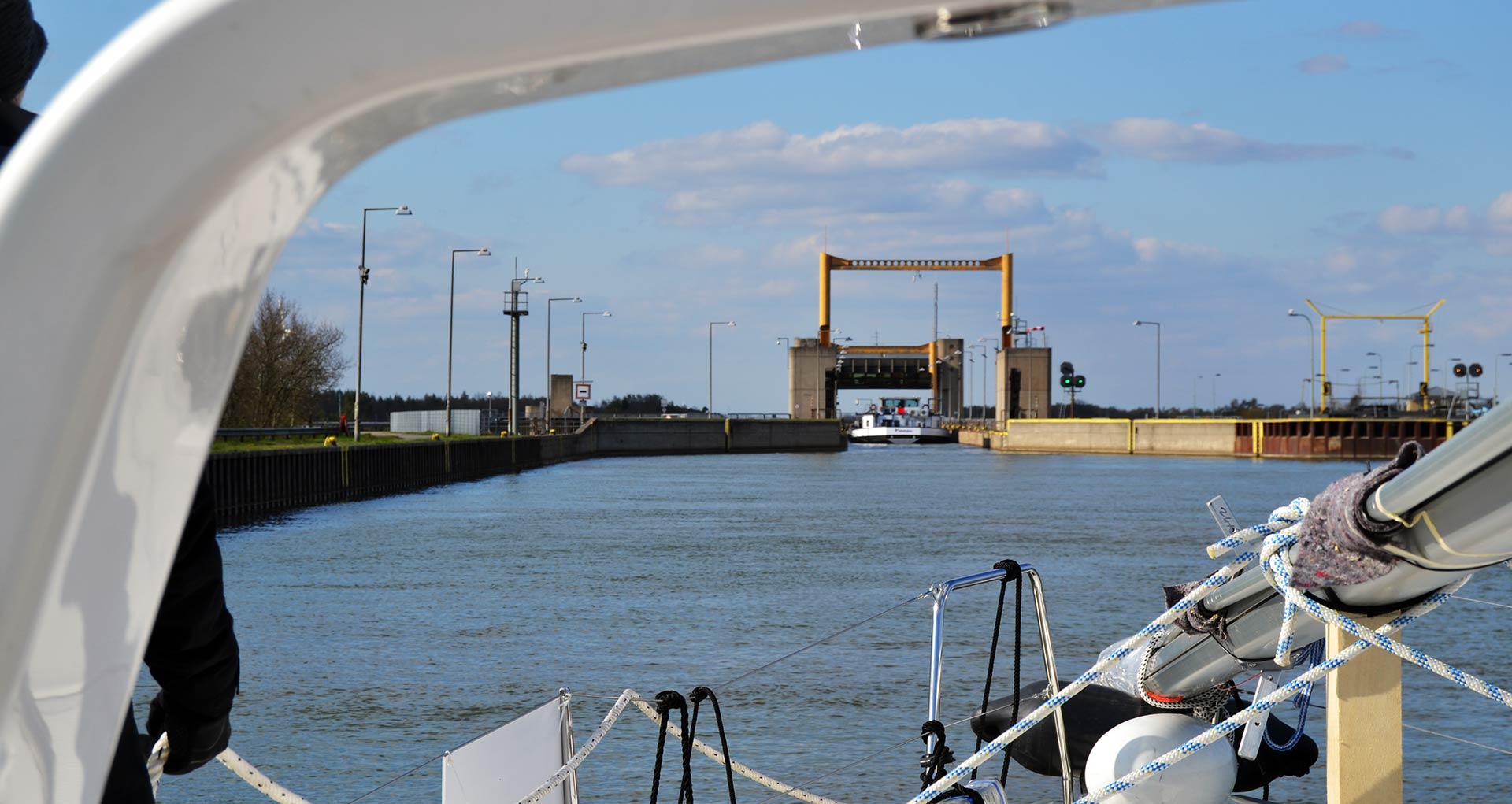
That said, when ordered to proceed into the lock, the lock master would say things like: “The sailing boat now proceed quickly into the lock please!” So, casting off and setting the throttle to go, I was nevertheless never speeding nor exceeding a safe speed. I thing it´s common sense that – regardless of how fast they would like to have you inside the locks – you are first and foremost responsible for a safe proceeding. When steering towards the lock, have your crew up and ready at the lines, because – now the fun part starts!
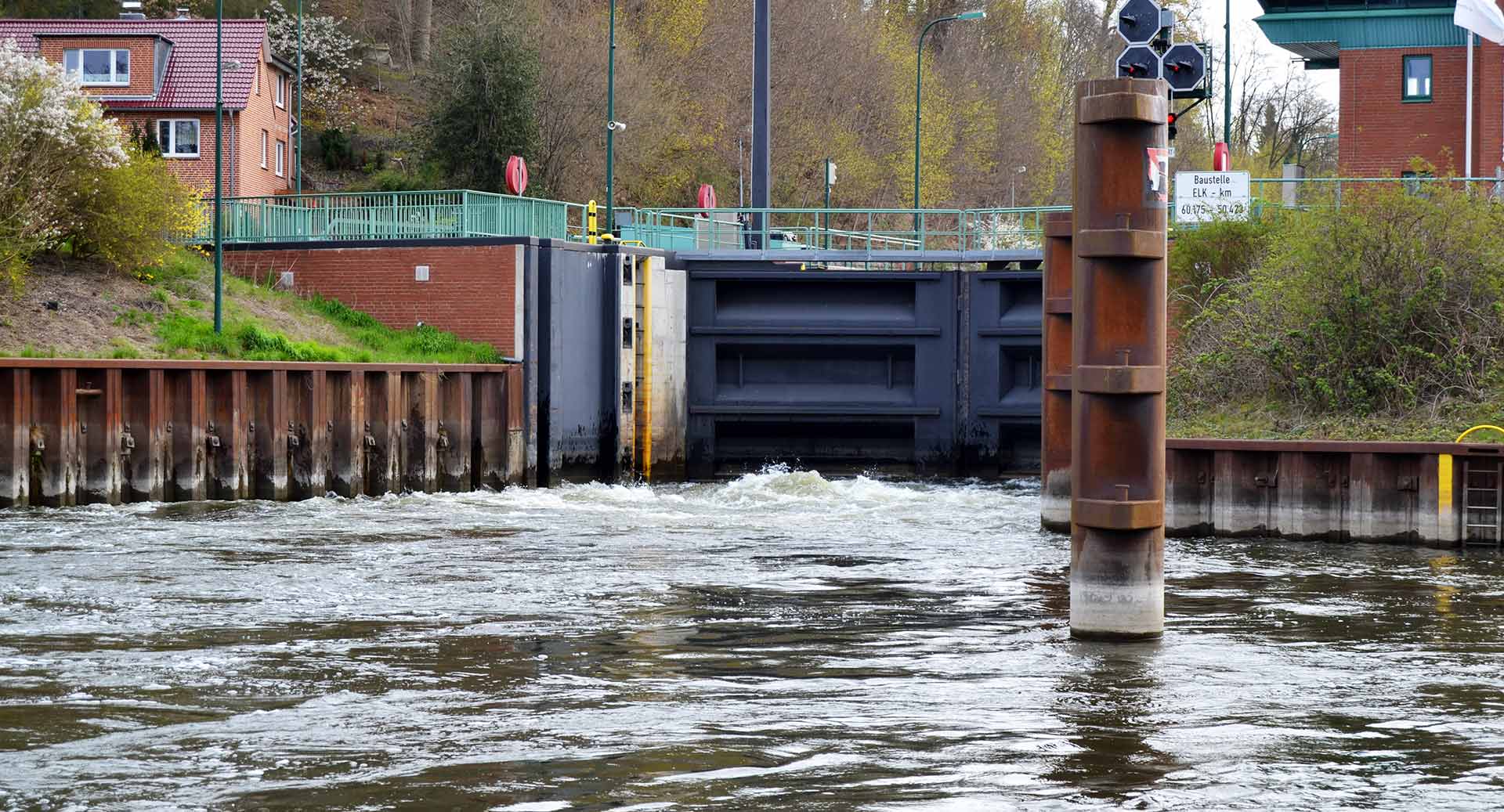
One word quickly to smaller locks: When you are waiting in front of a lock that is “coming down”, beware of the water that is coming out of the chamber. As you may see in the picture above, it´s creating quite some turmoil and strong eddies, so please have your boat tied up safely – the nearer a lock you go, the better have the boat guarded with fenders and ropes.
Preparing the locking of your Boat
Speaking of having the crew ready: I have two practical hints for people trying the same adventure as I did. First of all: Have all fenders ready. And have them ready at all times! That said, if there are a number of locks en route, take on extra fenders to your boat. In fact, on my 11 metre long Oceanis 35.1 I did have no less than 14 fenders guarding both sides, the bow and the transom.
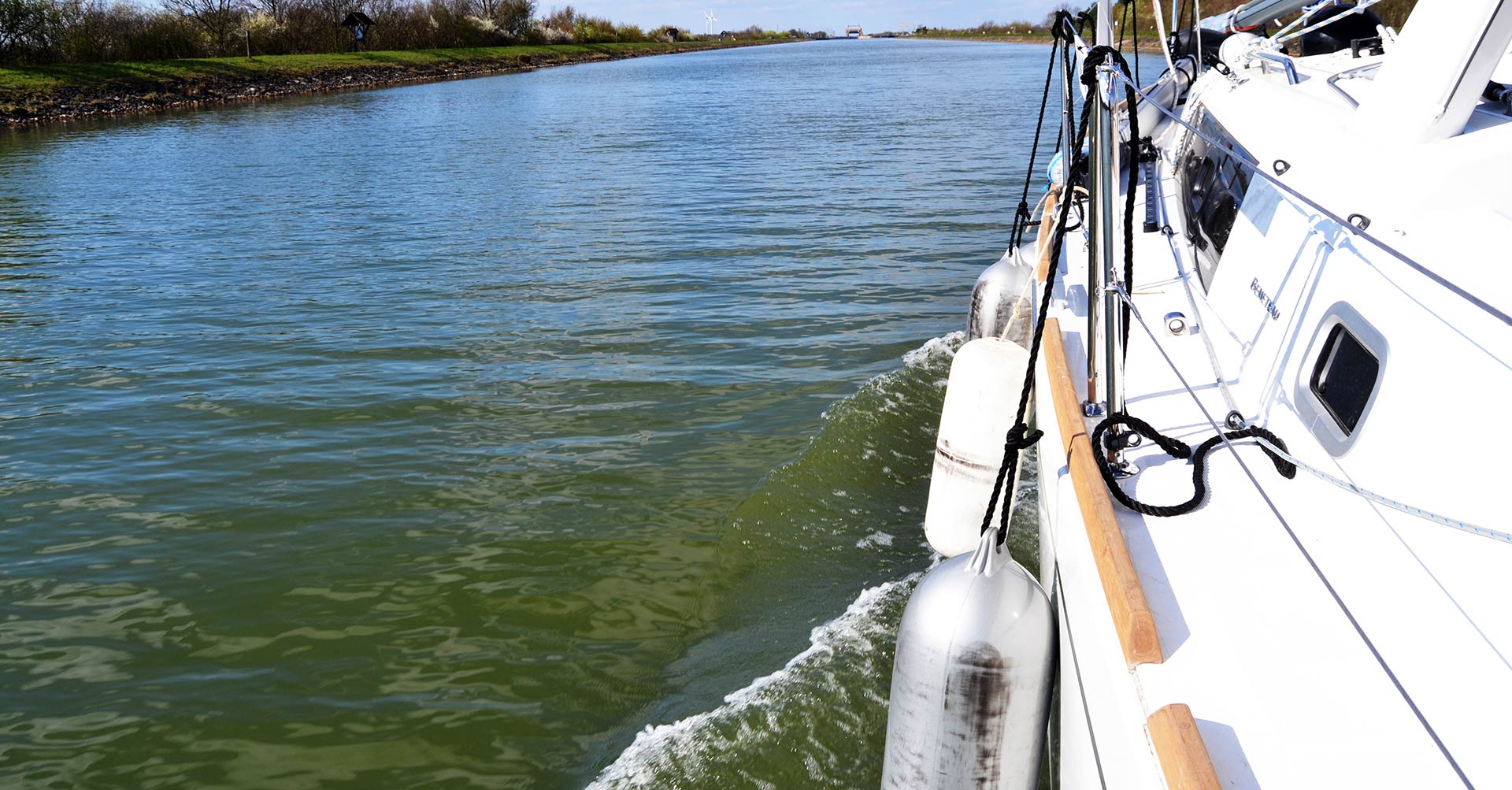
Why? Well, as you will see in the coming minutes, the boat won´t be tied up within the lock and during the locking process as steady as you may used to it. It will drift and bump around a bit. When you are doing your trip during the high season, you will experience a lot of other pleasure craft bumping around as well. So it´s a good thing to have all sides of the boat guarded at all times, no matter how stupid it might look like.
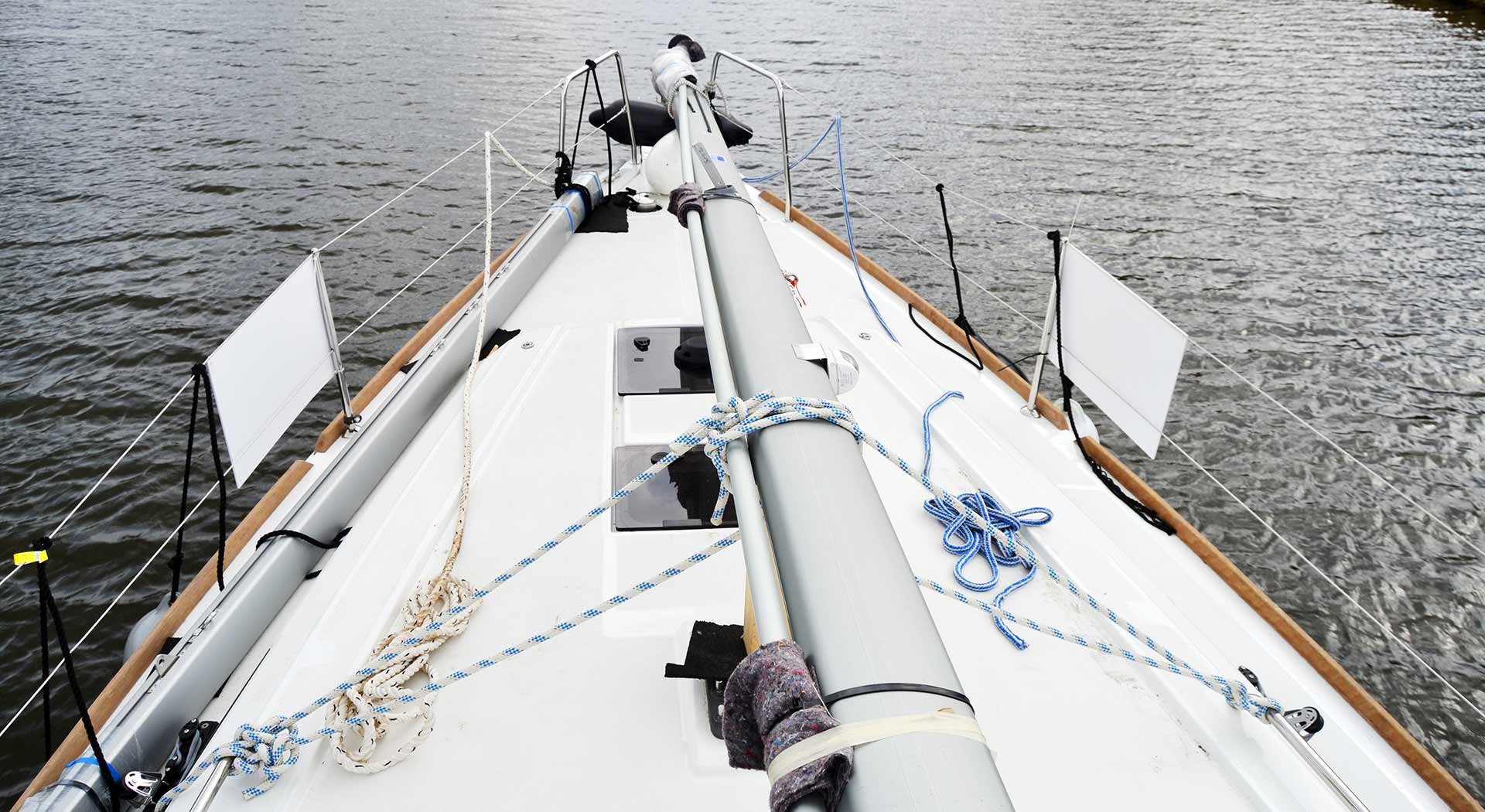
I would also recommend to have stern and bow lines ready at all times – both ship sides as well! Why? Because you never know a) at which side the designated waiting are will be and b) at which side of the lock it will be best to have the boat tied up for locking process (I will explain later). So, especially the bow lines must be ready and taken back to the wides point of the boat so that the bowman or woman can have the boat secured quickly. But now, let´s head into a lock and start the exciting venture!
Safer locking: Some quick hints
Not one lock is like the other. Or let´s put it this way: There are easy locks and not-so-easy locks. An easy lock may look like the one shown down here: There are bollards and ladders, there is quite some room for us and – best of all – it goes down. Going up almost always means that you will have to advance the lines to a new bollard or step of a ladder whilst going up. When going down and the height difference isn´t that much it means that you may just veer the lines.

In any case and no matter if going up or down, try to have as much distance between you and other ships as possible. Again, that may not be possible during high season when 10 or more pleasure craft are stuffed into the locking chamber, but if possible, keep your distance. Why? Because sometimes commercial ships won´t stop their engines and screws from turning: That will create eddies and vortexes which are pushing and pulling on your boat. Not very cool.
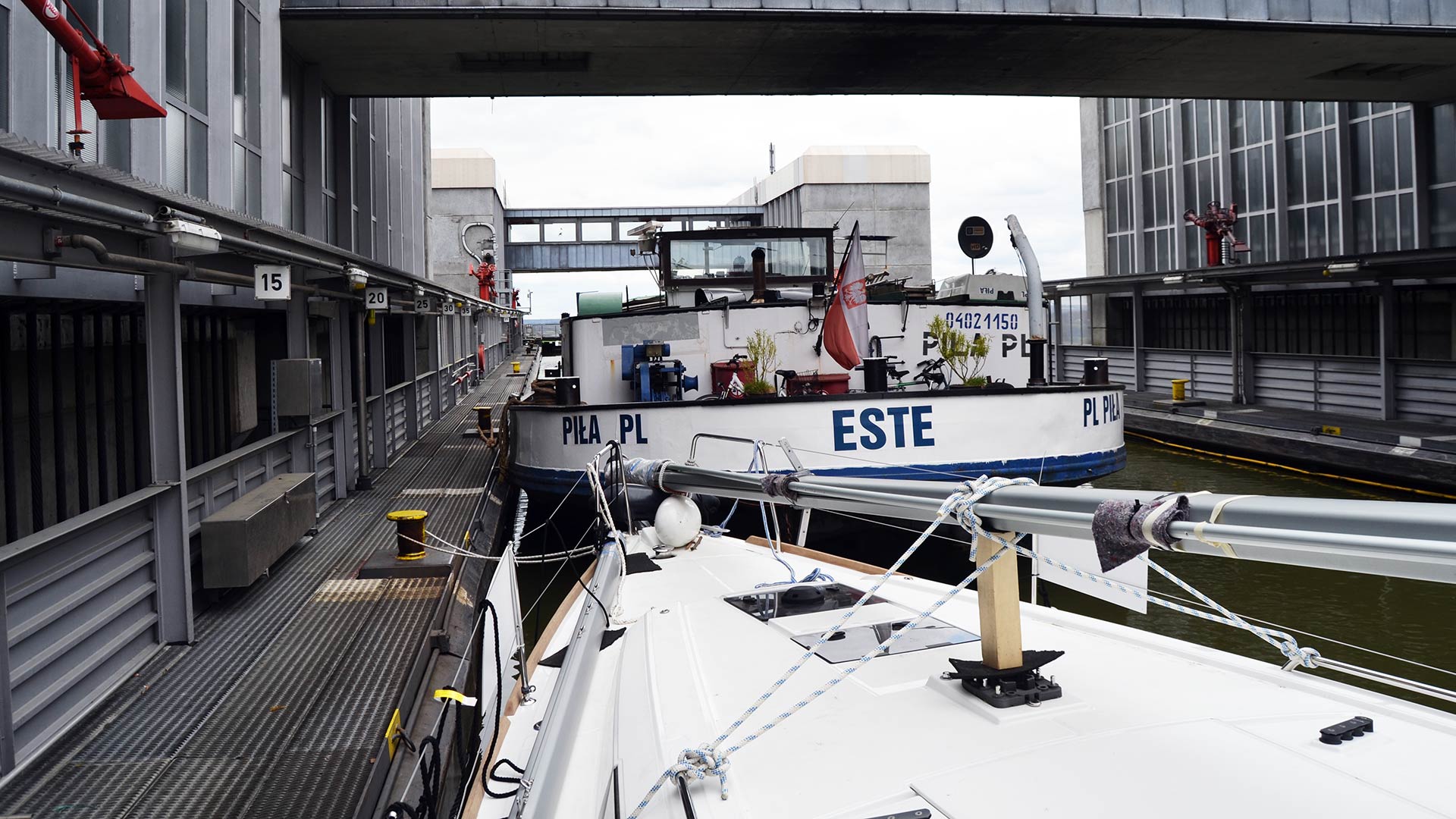
So, if you cannot keep distance to other boats, especially to the large inwater vessels, have the crew briefed and concentrated ever more on the matter. The same that applies to flowing water in front of a lock is also valid for being inside the lock, especially when it is going up. Large valves in the bottom of the chamber will open up, hundreds and thousands of litres of water will immediately flood the chamber. This will make the water “boil”. Again, eddies and vortexes will push and pull on the lines. Be aware of this!
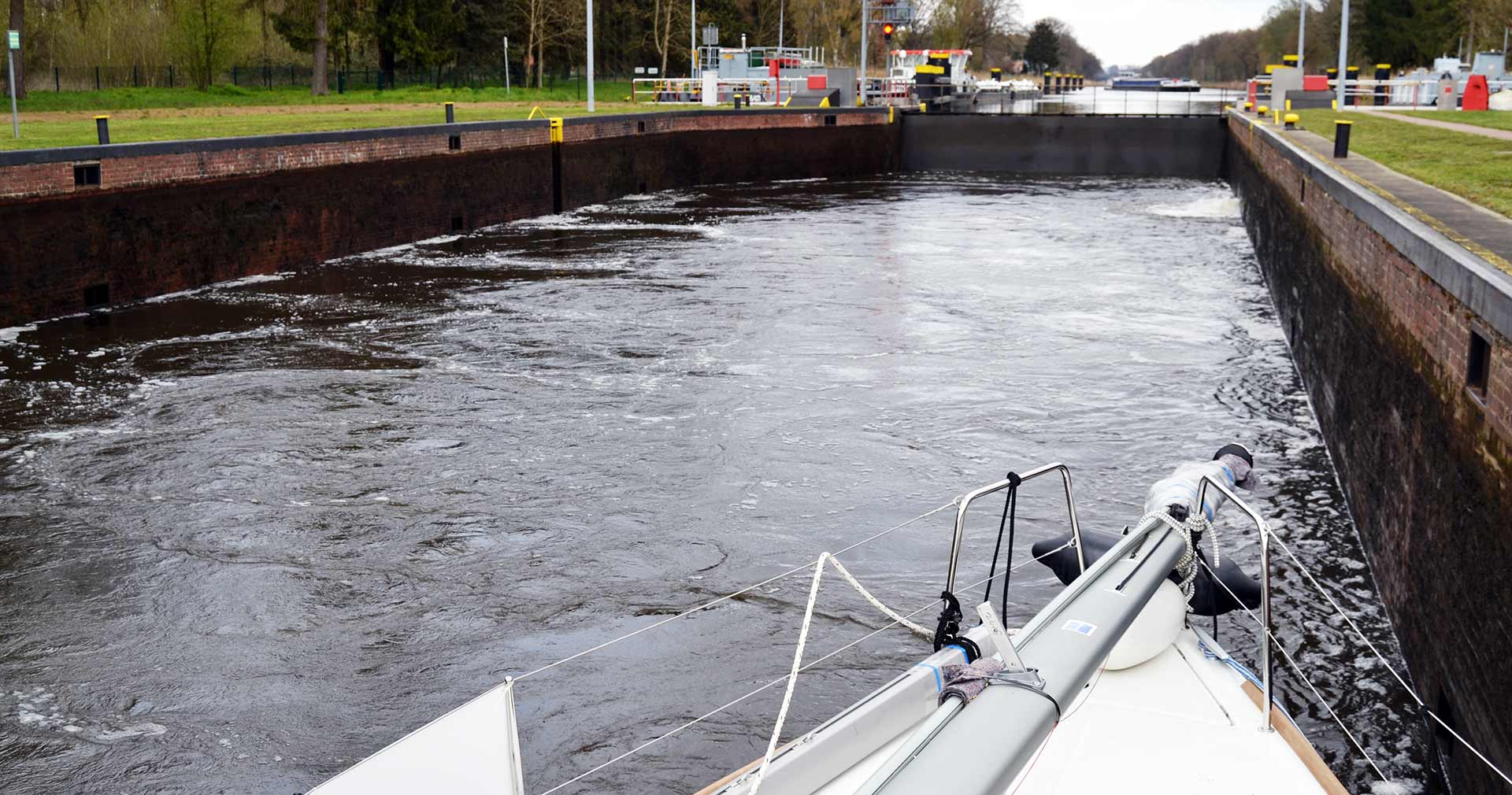
Apart from this, I find it essential to keep calm. Locks aren´t frightening nor a horror. They have their own properties and must be tackled in a certain way. But in no way should you be in awe even of the largest locks: We´ve made altitude changes no less than 25 metres and more and it was always very exciting and fascinating. If you have a fresh and clean mind and keep concentration high, you will master it, no matter!
Speaking of Ropes …
Have I mentioned that we´ve mastered altitude changes of more than 25 metres? Well, believe me, entering a lock chamber with wet walls as high as these is a very, very special feeling. The sound is reflected from everywhere and it will suddenly turn colder. You stand down there and raise your head in admiration – even the big bulky ships suddenly appear so small and fragile. Now, there are different techniques to have your boat tied up safely whilst locking.
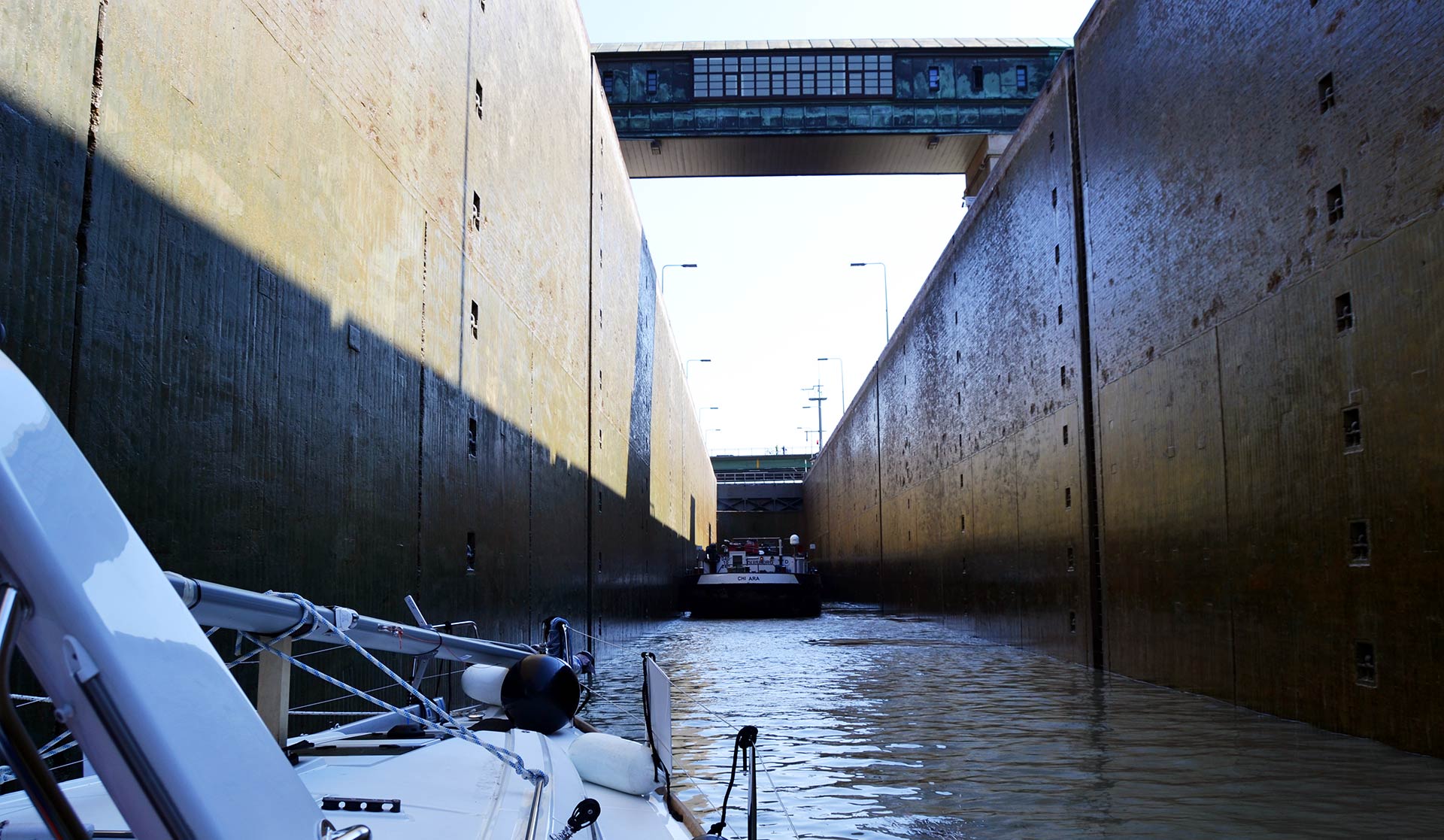
You may find lugs like the one shown in the picture below. These lugs are sunk into the walls and may be installed with some 5 to 10 metres distance to each other. I always had my boat tied up like this: Both lines, bow and stern line, went to the same lug in the middle. Thus, the lines were acting as springlines. Because my boat was protected by fenders, there was no problem when bow or stern where moving around. Have the lines put around the lug and kept tight at all times.
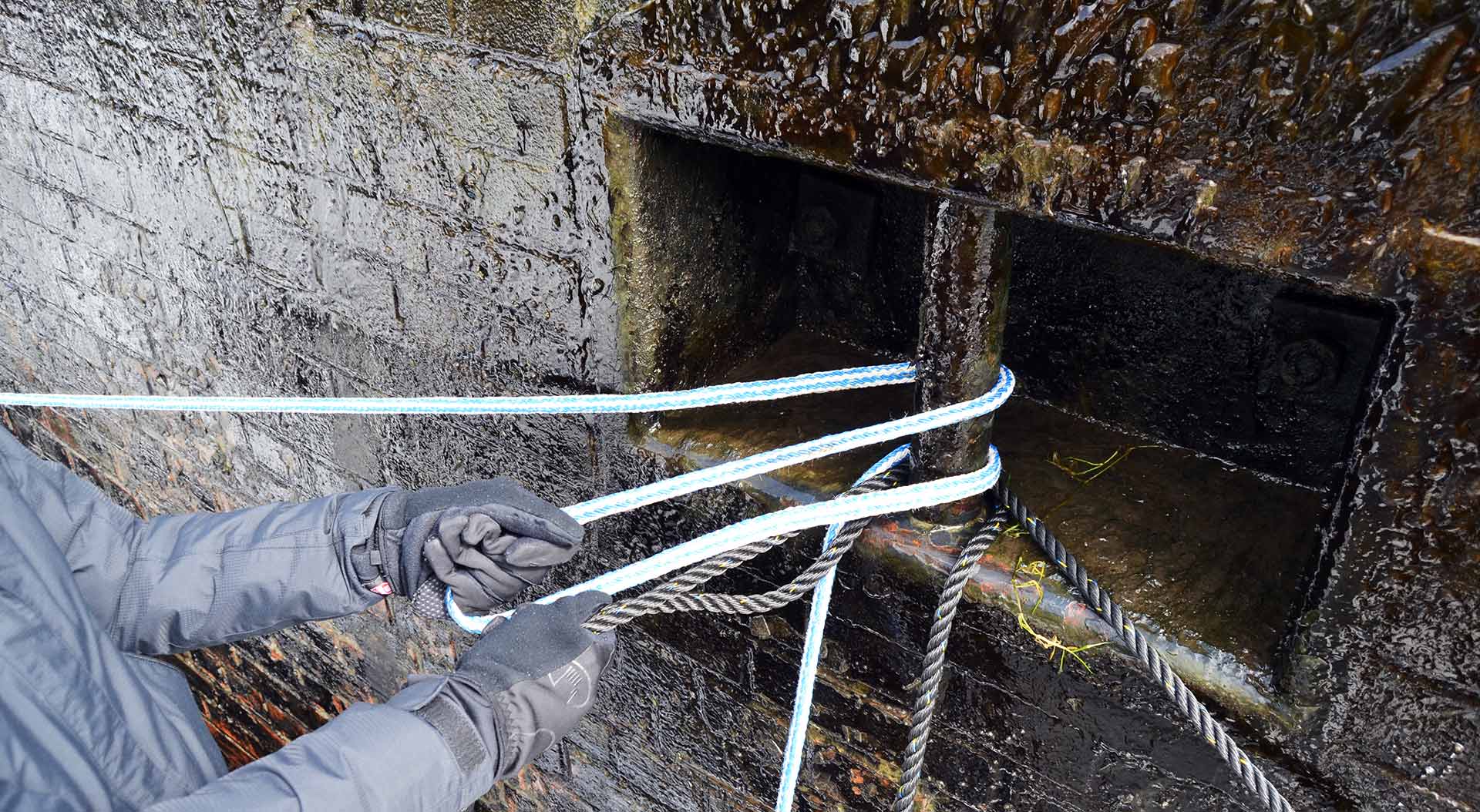
When the boat is rising (or falling), a new lug right above or below the lugh will appear every 2, 3 or 4 metres. So, there is one crew member for each line and thus they will co-ordinate when one will transfer his line to the next lug. At no time should both lines be disconnected from the lug, of course. More easy than lugs are ladders as seen here, because you can choose the step most convenient for you to have the line put over.
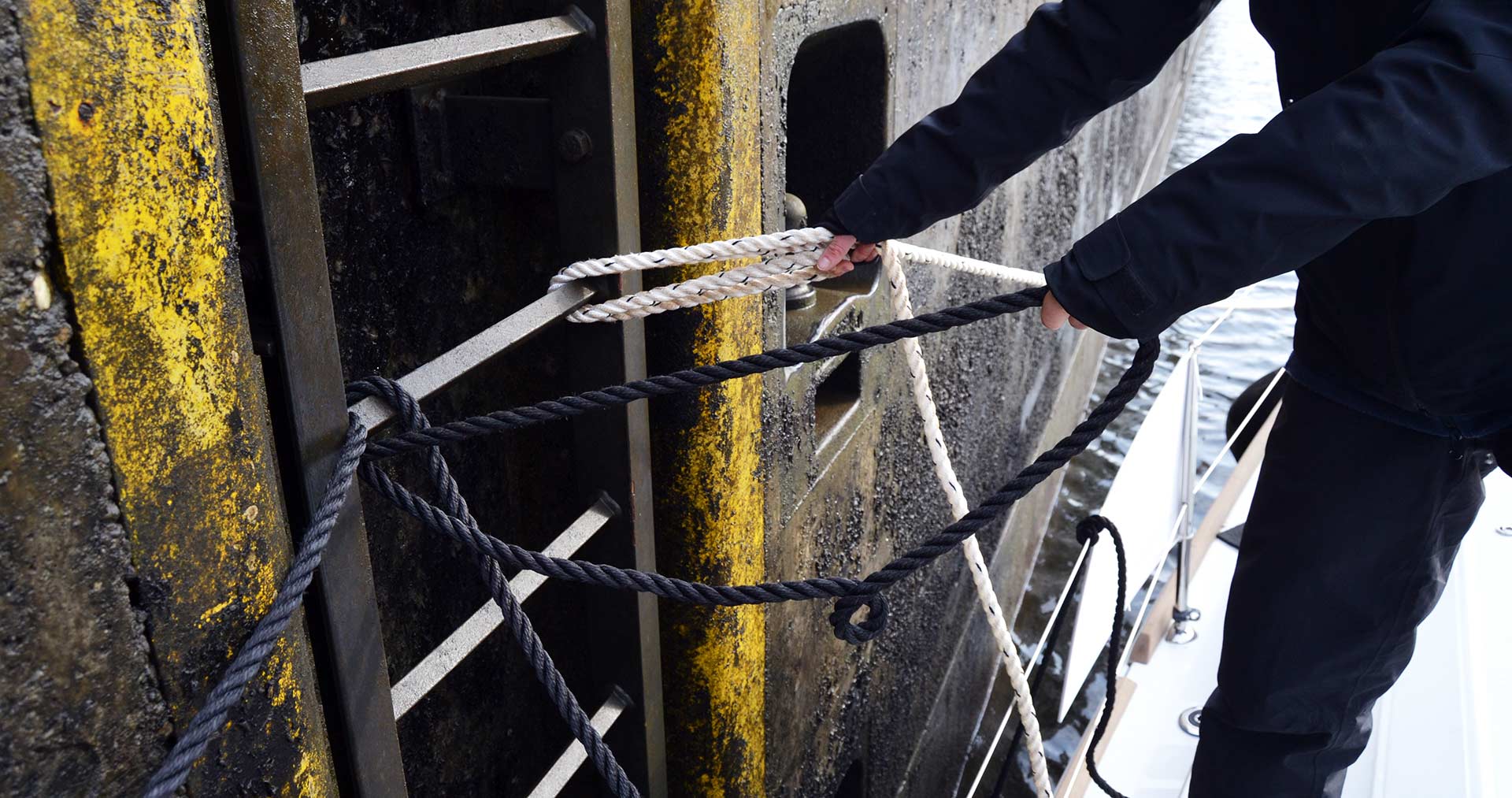
Most comfortable but very rare are bollards that will come with you. In fact, of all the 10 lock I did experience on my trip, just one was equipped with these. In that case, you can have the boat tied up stationary with now line guard assigned. The bollard will keep its position in relation to your boat.
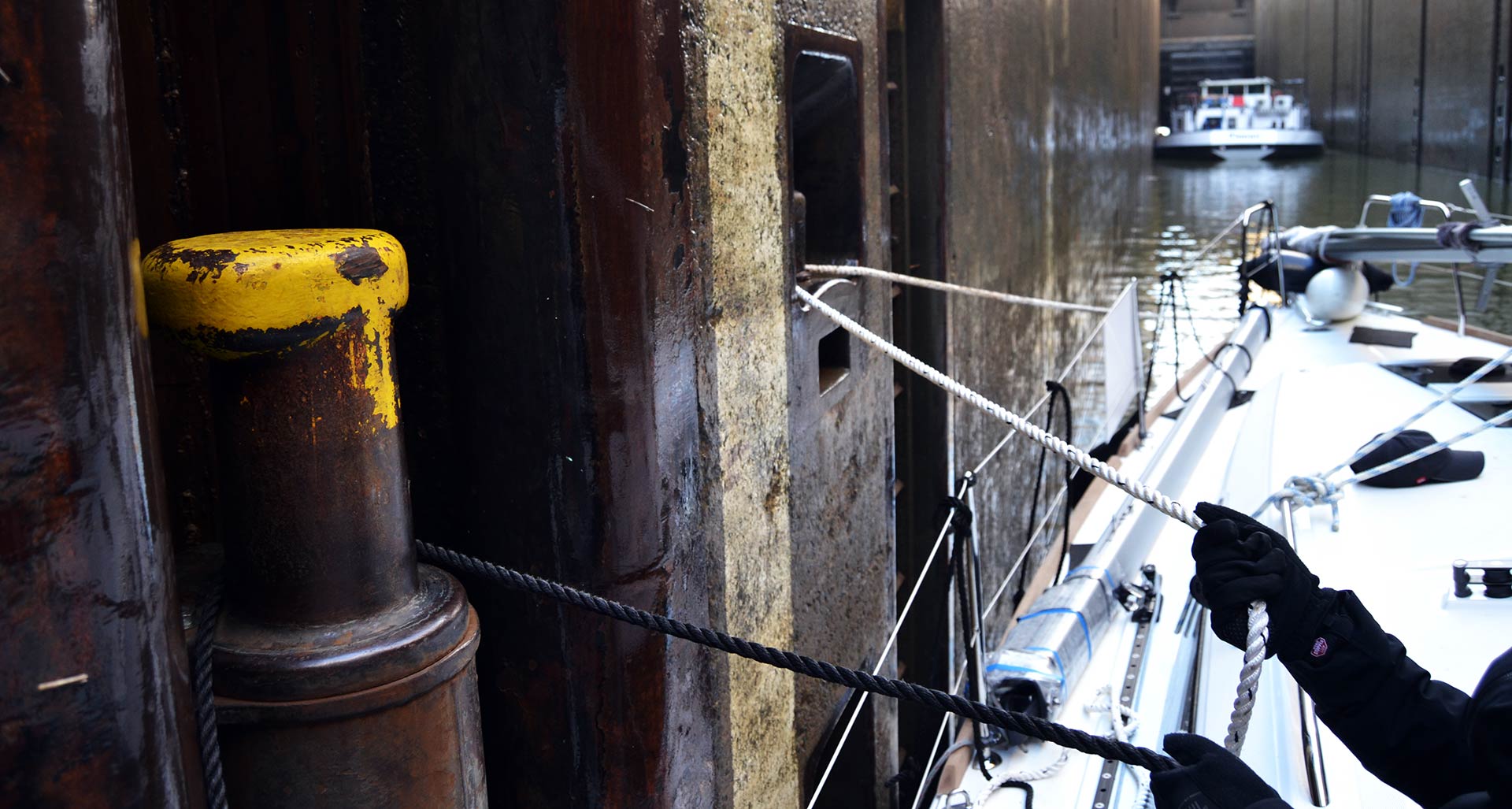
No matter which of there you might experience, you should be aware that at least two lines are to be attached to land when locking. As a good skipper you will have the engine turned off during locking proceeding and thus there is no chance to safe the boat when lines are disconnected – you will start drifting inside the chamber and most certainly damaging your boat and other properties. So please be safe here at all times.
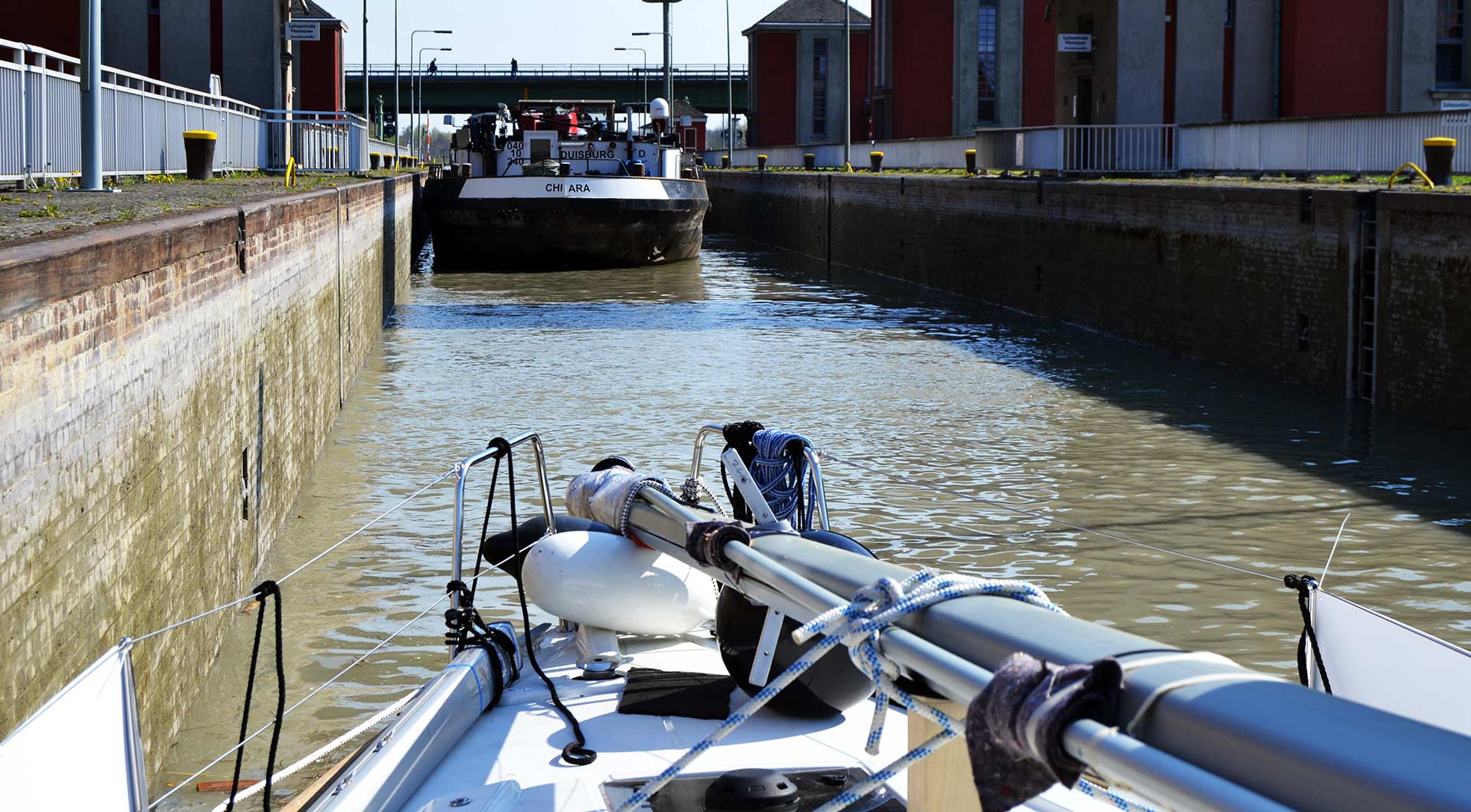
A quick word to leaving a lock. Again, the lock master may tell you via loudspeakers to leave the chamber quickly. I did as following: I waited with casting off until the big commercial traffic had left the chamber for sure. And I instructed the crew not to let loose on the lines especially when the big ships started their engines: They will push full ahead and cause the water inside the chamber to be wild and boiling ever more. Not unless the commercial ships had left the locks at full length, I proceeded to start my own engine and leave as well. On one occasion the man on the speaker said: “Quickly leaving – or you come back up again!” I laughed and waved at his command center way above me.
The Fascination of Water Construction
Let´s have a more detailed look at those fascinating sites: One of them was the big lock in Uelzen which is one of two big locks on the Elbe-Seiten-Canal that was built in the Seventies by Western Germany when the Mittelland-Canal became unavailable for inwater commercial shipping and tis new channel opened up a route between the North- and Baltic Sea to the industrial areas of the middle of Germany. Uelzen is a massive thing!
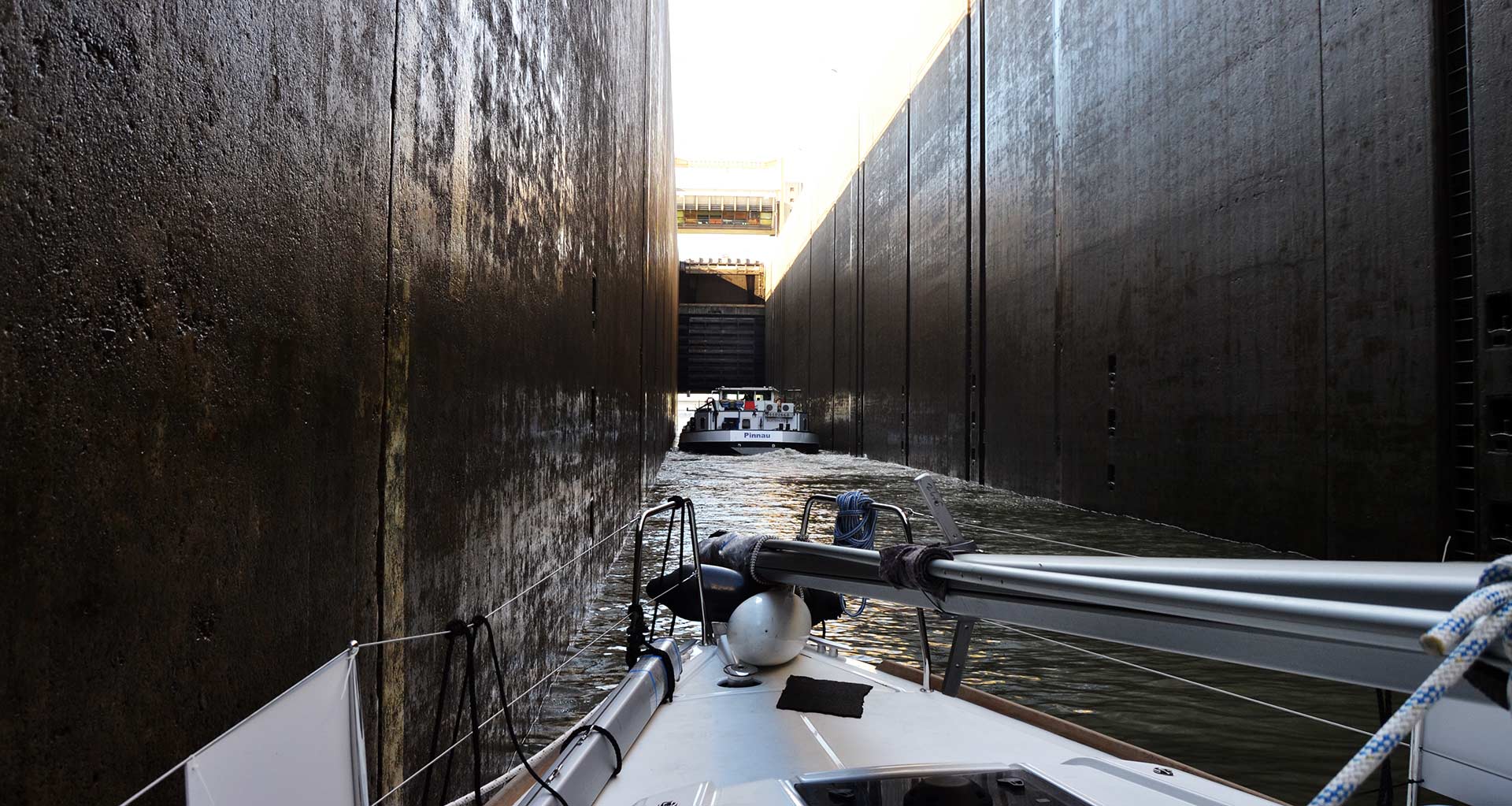
In fact, Uelzen is the biggest so called “water saving lock” of the world. Ordinary locks are filled by the water that flows through the river, they are feeding on the river. When going down, that water is released and thus “lost”. It isn´t lost when it comes to river-locks, but a canal has no water replenishing the “lost” water so with every locking-proceeding thousands of tons are lost. Not so with Uelzen – not less than 4 huge chambers made of concrete to either side (making a total of eight) are stacked on top (!) next to the two big locking chambers.
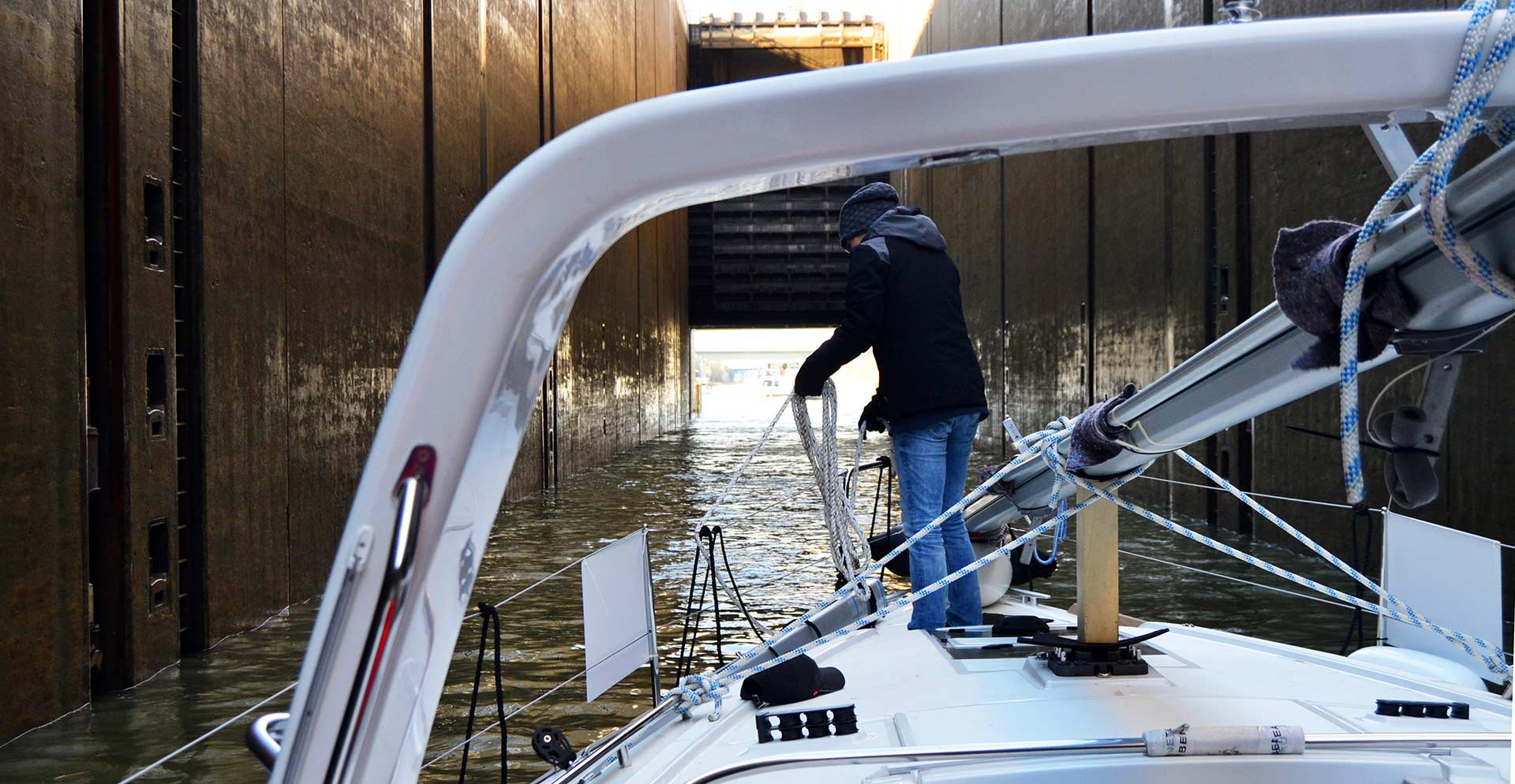
So, when going down, the water isn´t just released to the lower side of the channel but will go into those holding chambers. In this way, up to 70 per cent of the water can be used for four times! This is incredible engineering and one of the most exciting constructions I´ve seen and witnessed in my whole life! When we entered this lock we have been the only pleasure craft along with one commercial ship. This lock beared one of these bollards that travel with you, so it was easy locking. But imagine this sound, like the groaning of a hundred dinosaurs when the steel of the ship was dragged up along the steel-framed lock chamber. Awe-inspiring!
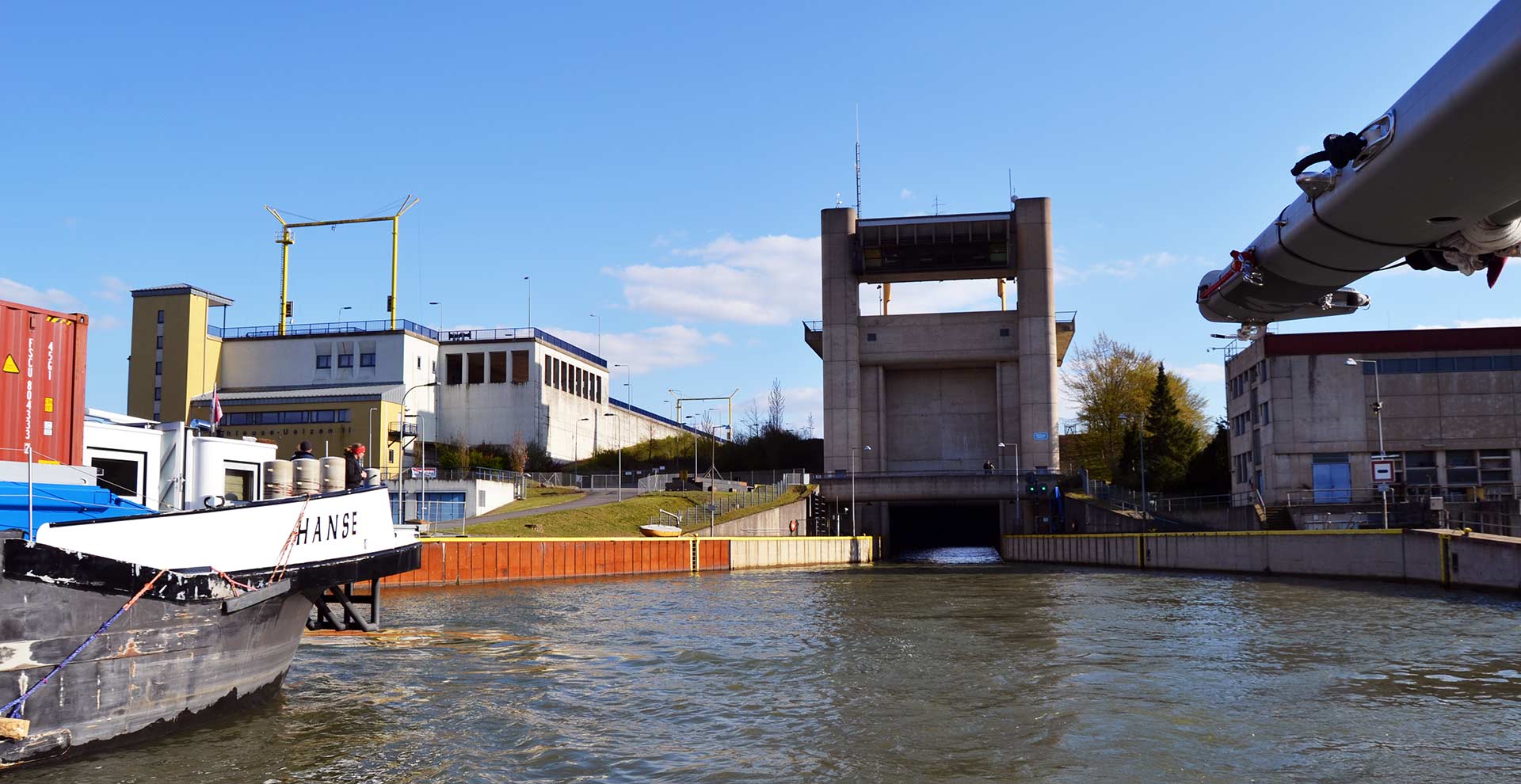
When I steered the boat out of Uelzen lock and looked back, I was still shivering by this experience. Really, it is crazy to think about the fact of what humans are capable of achieving when they use their power, their money and their time to do something good. Uelzen can manage up to 80 locking proceedings per day. But this thing wasn´t even the biggest highlight (from a technological standpoint), as it was still due to come: A ship´s lift!
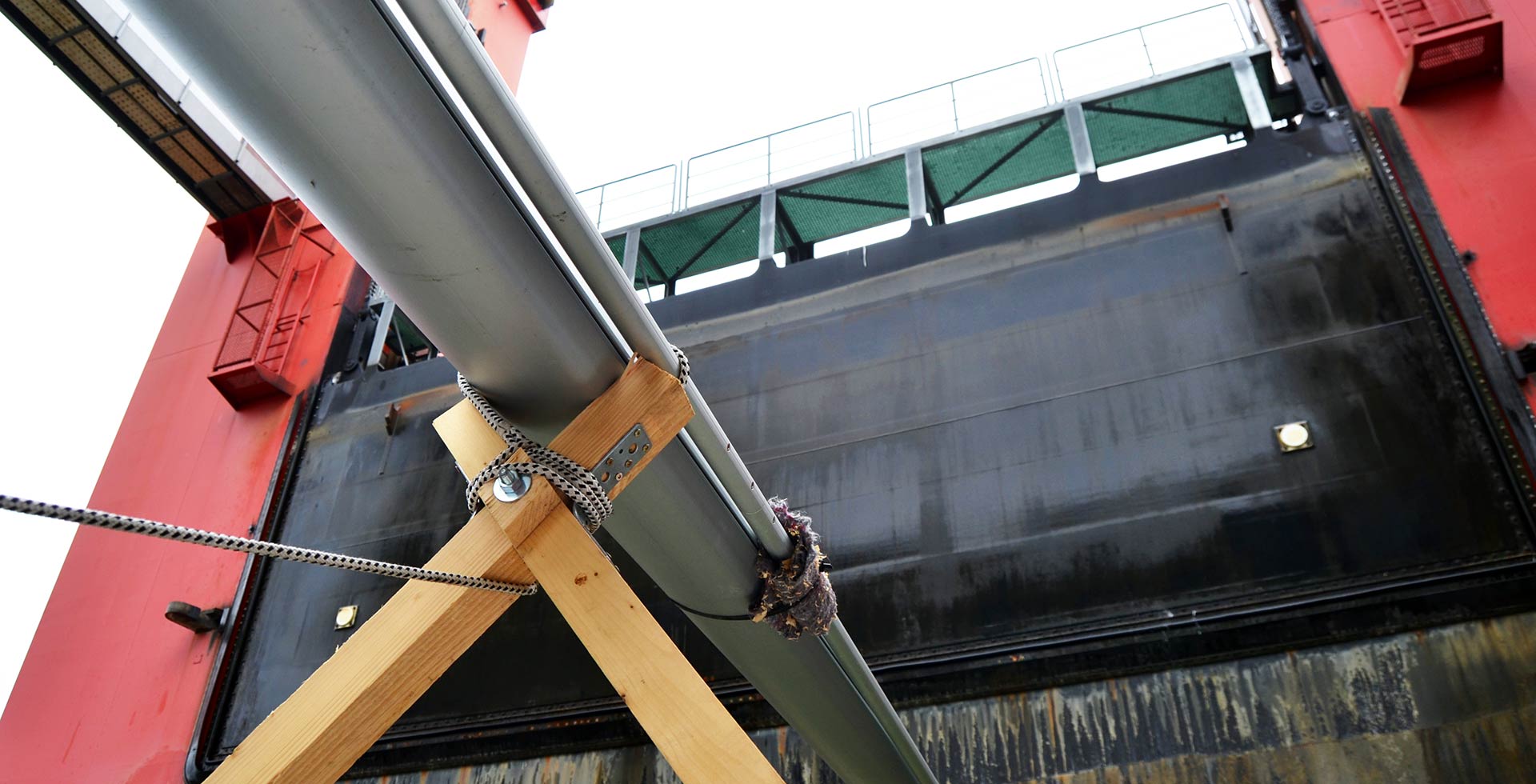
At the Northern end of the Elbe-Seiten-Canal there is Scharnebeck, a natural formation of smaller mountains which had been chosen to have the channel´s end. The challenge: altitude difference here is no less than 38 metres! So, after calling the master I again was ordered to wait along the jetty for a ship to enter the lift. It took one and a half hours to arrive and right behind it our boat entered the steel-made trough. When the large door came down and the canal was cut, the trough began to move down. We just held our breath!
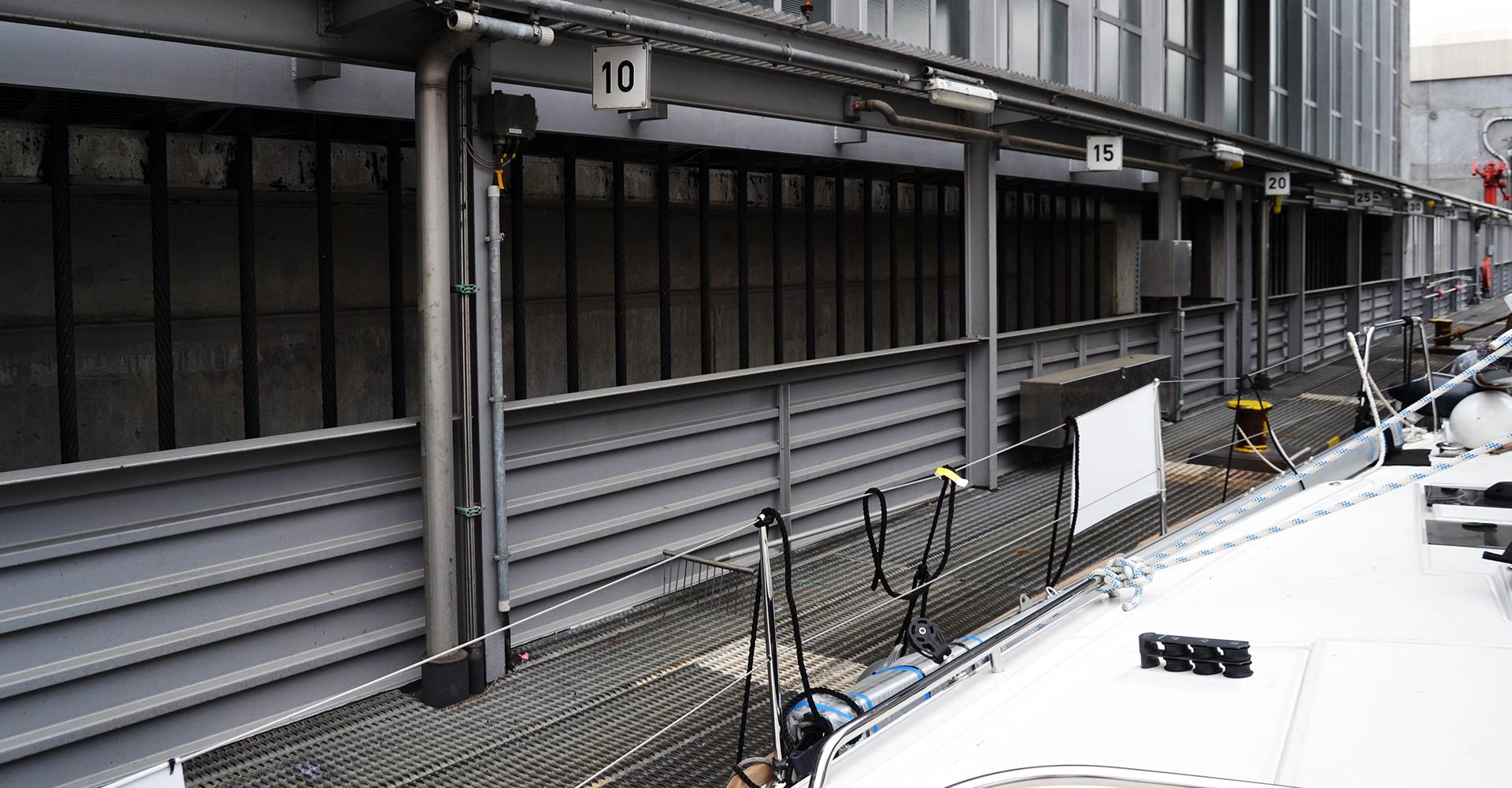
The trough is hanging on 240 steel-cables each as thick as 5.5 centimetres. Including water and ships the trough weighs in exactly 5.800 tons. It is weighing this all the time, no matter how many ships the trough is transporting and how big they are – because each ship will displace exactly the amount it weighs.
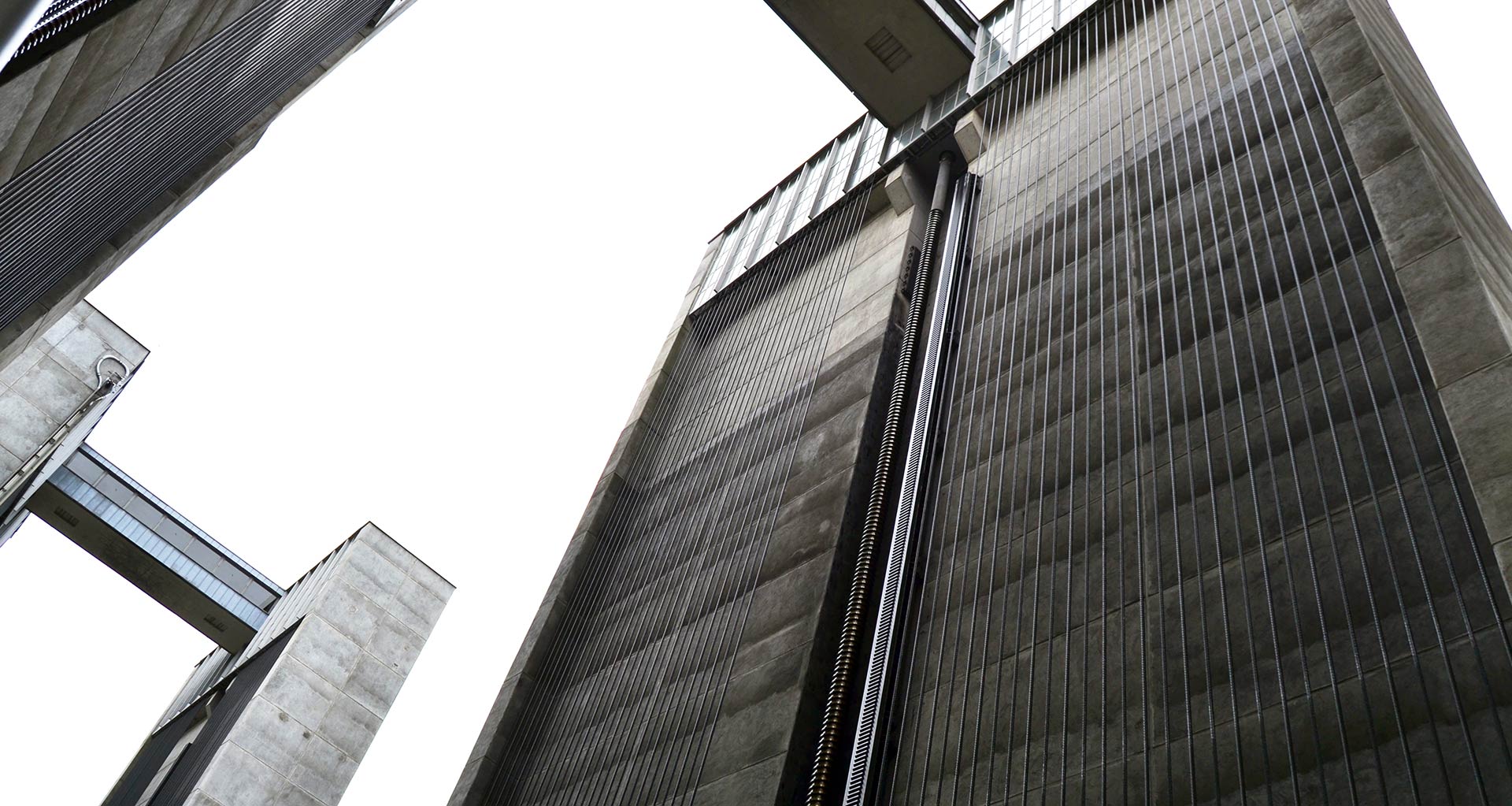
The advantage of having a ship´s lift is a matter of fact: You do not “lose” water in a way a lock does. You can also tie up the boat more quickly and more safely, you can even walk inside of the trough (although it´s not permitted to do so). The 38 metres of Scharnebeck are travelled in about three minutes. Almost effortless, because an the other end of the cables are weight which also weigh exactly 5.800 tons. Just 4 very small electric engines are causing the trough to either travel up or down.
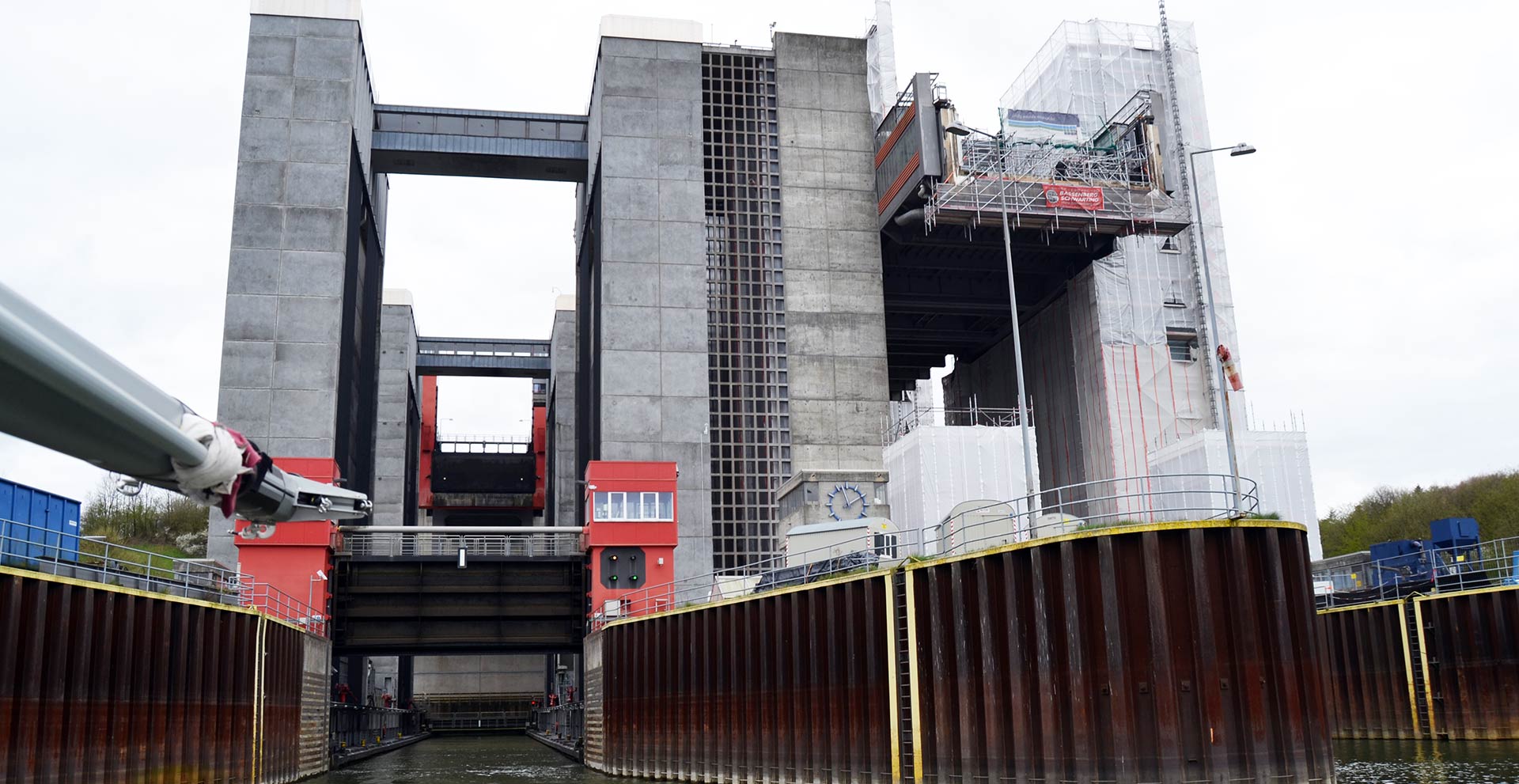
The trough is hanging between two really impressive concrete towers which are housing the large wheels and the axle on over which the cables are running. In the middle of each of them four towers a very thick steel screw is mounted which acts as an emergency brake and holding mechanism in case something bad happens. Most impressive about Scharnebeck? One single man sitting in a control room is managing the whole ship´s lift by sitting in his chair and pushing buttons. The whole installation is sparkled with CCV-cams and opening, closing, up and down of the troughs is done by pushing buttons. I was deeply moved when we finally left the ship´s lift and entered the waters of near River Elbe, finally having travelled all the way up north the Elbe-Seiten-Canal. Truly amazing!
Canal Travel is Daylight Travel
You know that I have a certain affection for sailing in the darkness. I love having the stars above me and the “quietness” that comes with the night. Unfortunately, sailing by night in inshore waterways is prohibited. Well, not really, but your are advised to be underway no sooner than 6 o´clock in the morning and should be tied up and resting as late as 10 p.m. in the night. You better do so, because unlike the commercial watercraft all being equipped with radar, we didn´t have anything. And the canal isn´t lid up by lights.
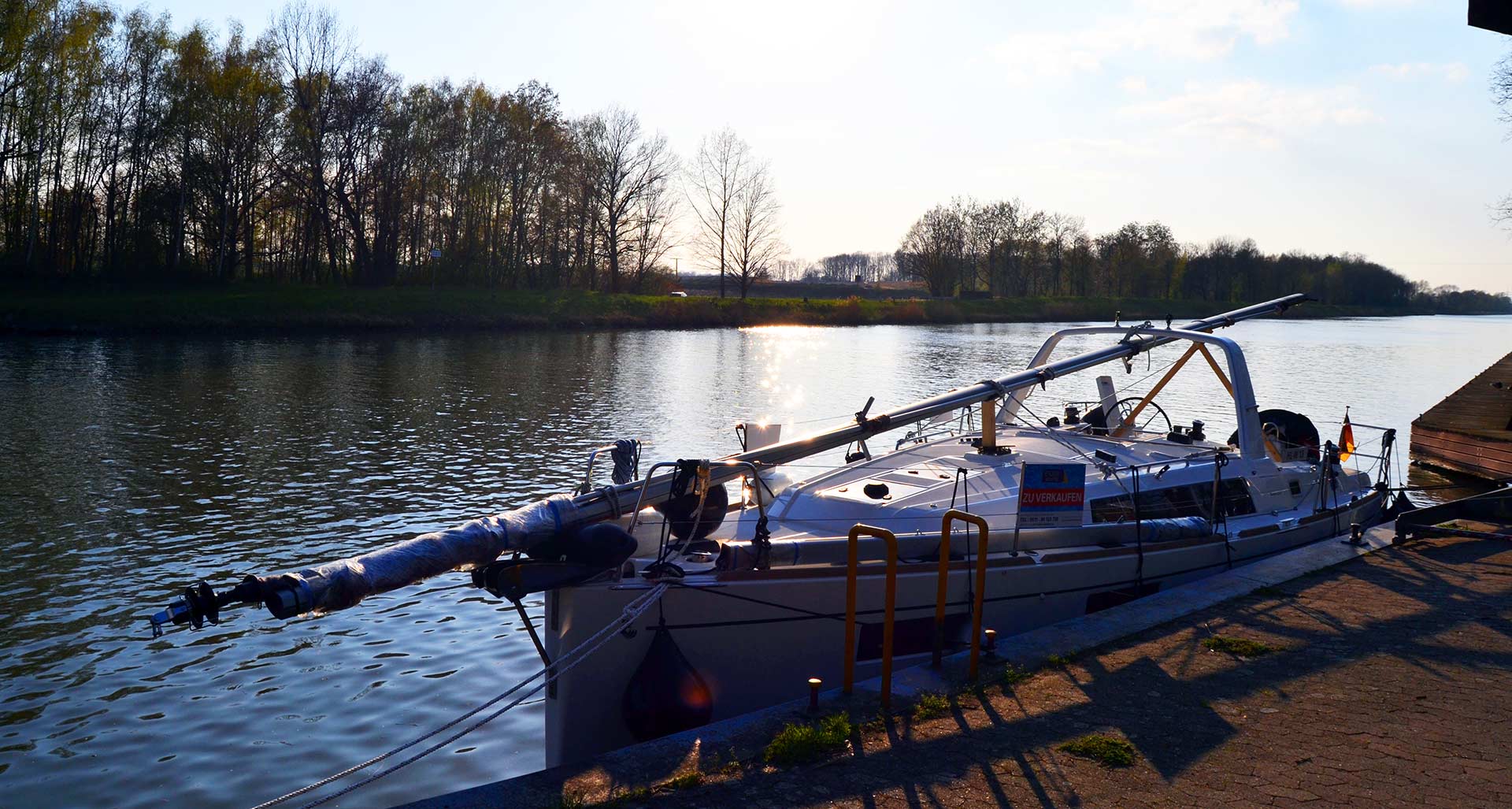
So, where to go? There are numerous yachting clubs and marinas even aling the canals, not one farther away from the next more than 30 miles. But we had been underway with a sailing yacht and although my boat was equipped with a shallow draft-keel (of 1.56 metres), most of those marinas didn´t offer the right draft. Which is a no-brainer: Inshore watercraft are mostly powerboats with barely more draft than 1 metre. So, I needed some alternatives. And there are so many!
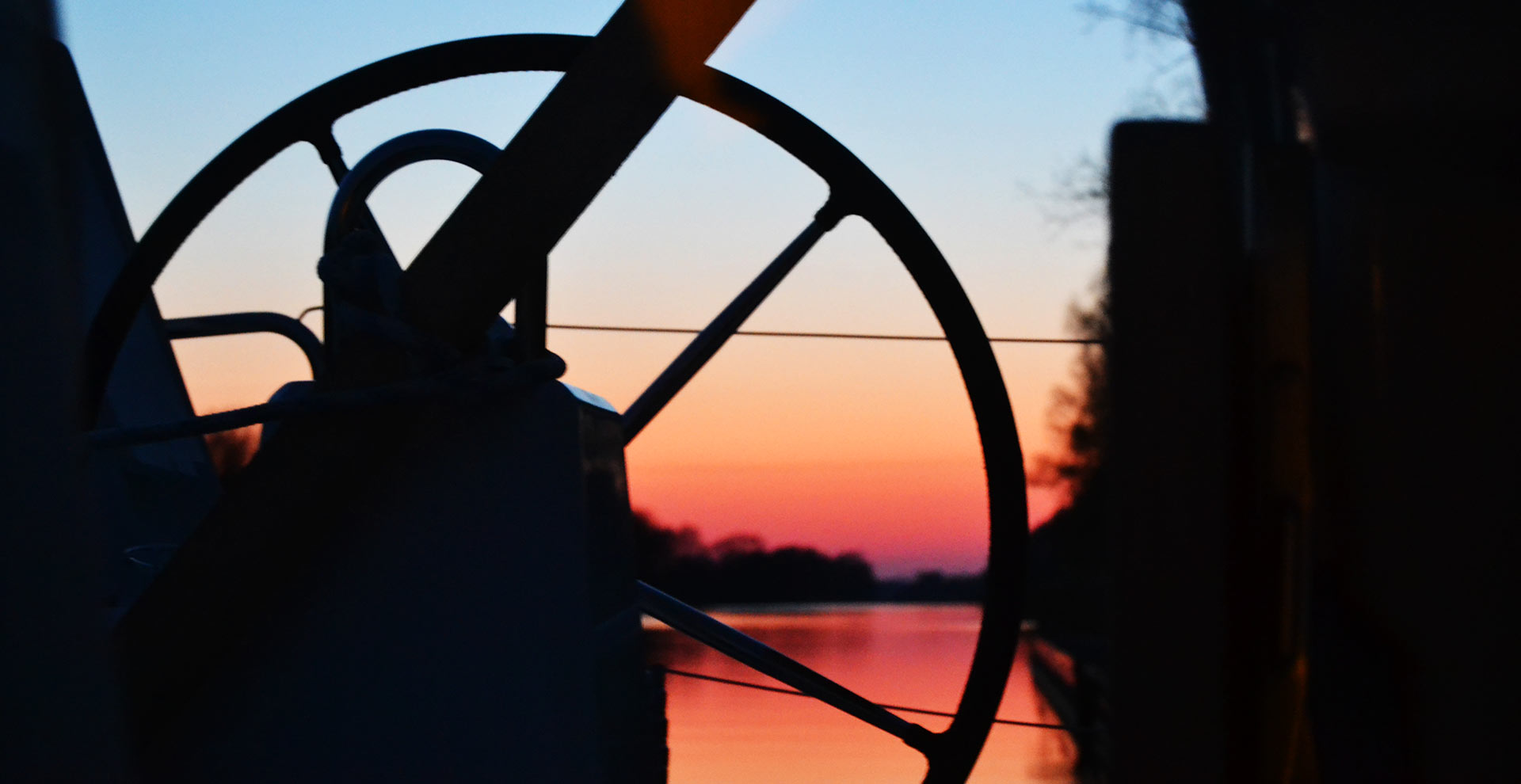
In regular intervals the canals have steel pilings of often more than 200 metres in length. These are clearly marked as jetties for the commercial ships to have them tied up for the night. Most of those “harbours” do also have marked areas for pleasure craft, three to five boats can find a safe place for the night here. The only downside: There is no shore power so that means feeding on batteries here. On the other hand, it´s a very, very, very calm and quiet place. There is no traffic over night and mostly these jetties are in the middle of nowhere – that´s a deep, peaceful good night´s sleep you are looking forward to!
Racing down the last leg: Elbe-Luebeck-Canal
Entering the northern part of the trip nature even more changed. As River Elbe is prone to massive tides, so is the small leg between ship´s lift Scharnebeck and the picturesque town of Lauenburg where I stayed over night. I welcomed Elbe because some 20 miles downriver I used to live for a large portion of my life. But we went some miles upriver, had a sleepover right next to the lock of Lauenburg which is the guard of the final and last inland waterway of this trip: The Elbe-Luebeck-Canal.
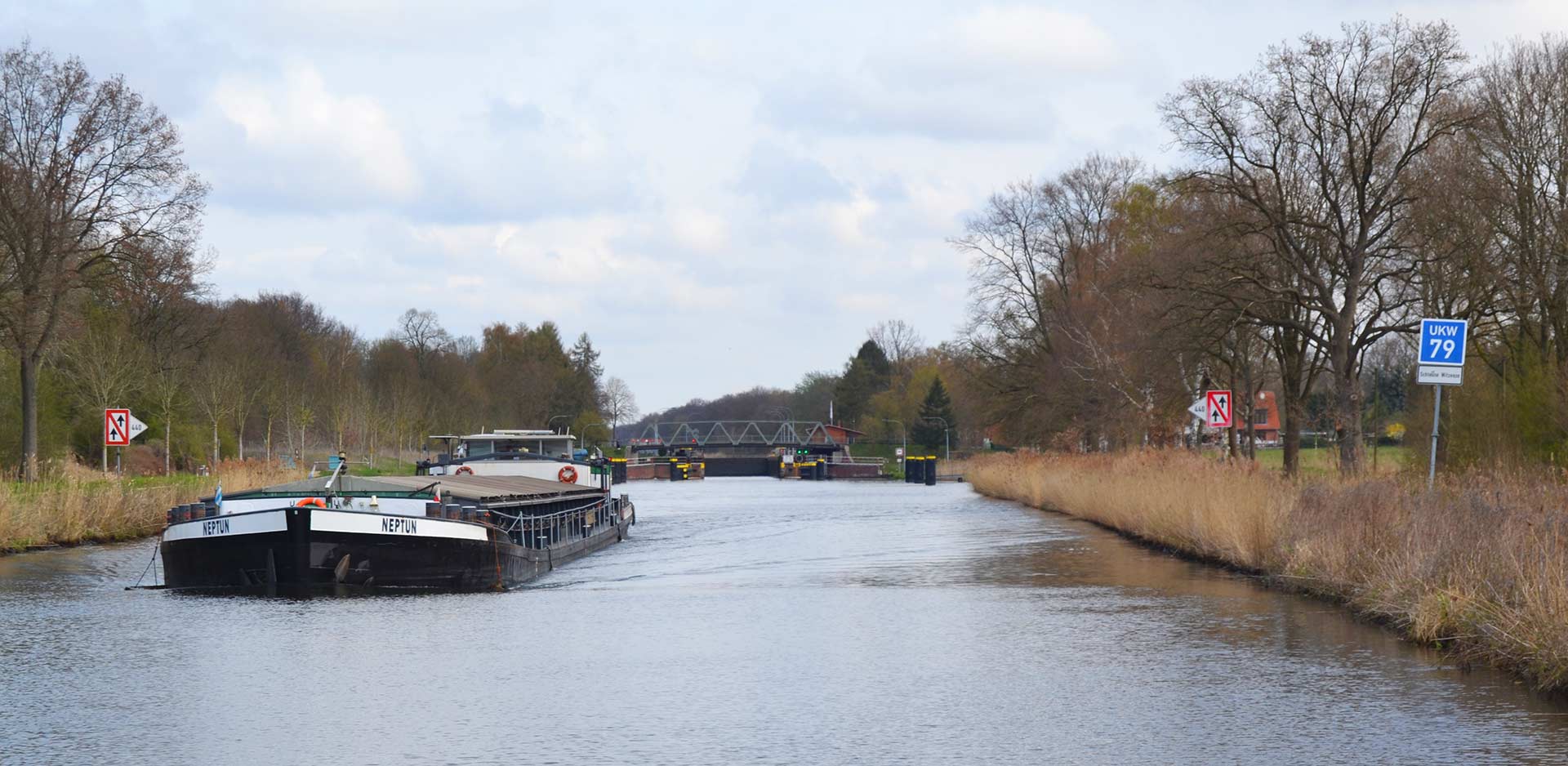
This is a very, very different picture. Far less commercial traffic (in fact, only one ship passed that whole day) and less modern construction visible. The channel appears like a natural river, which it of course is not, but it is rich of natural habitats, lots of animal life (especially birds like herons, wild geese, ducks and many more). The shore of the canal seems unfortified, but that´s just for the sketchy eyes.
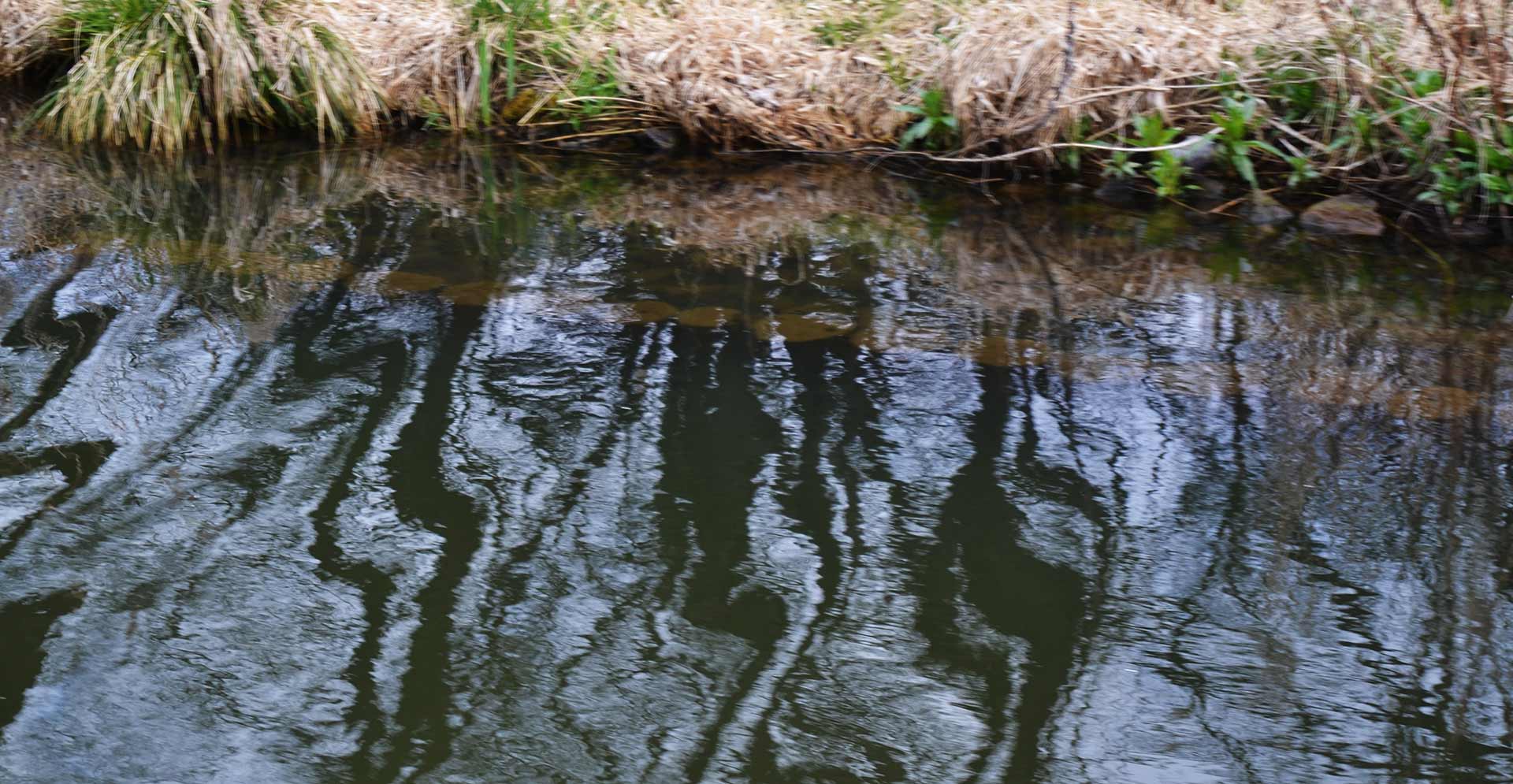
There are wooden pilings all the way and they are not visible. Just below the waterline and sometimes metres away from the dry land, these are constant lurking obstacles and any skipper being around here is well-advised to steer clear from the shores. Did I mention that nature changed? It got rougher, harder but also more exciting. As the distance to Luebeck was as low as 60 kilometres, we experienced a real tough wind coming directly from ahead and rain showers (even snowy grains!) alternated with clear blue skies and pure bliss delivered by a perfect spring sun.
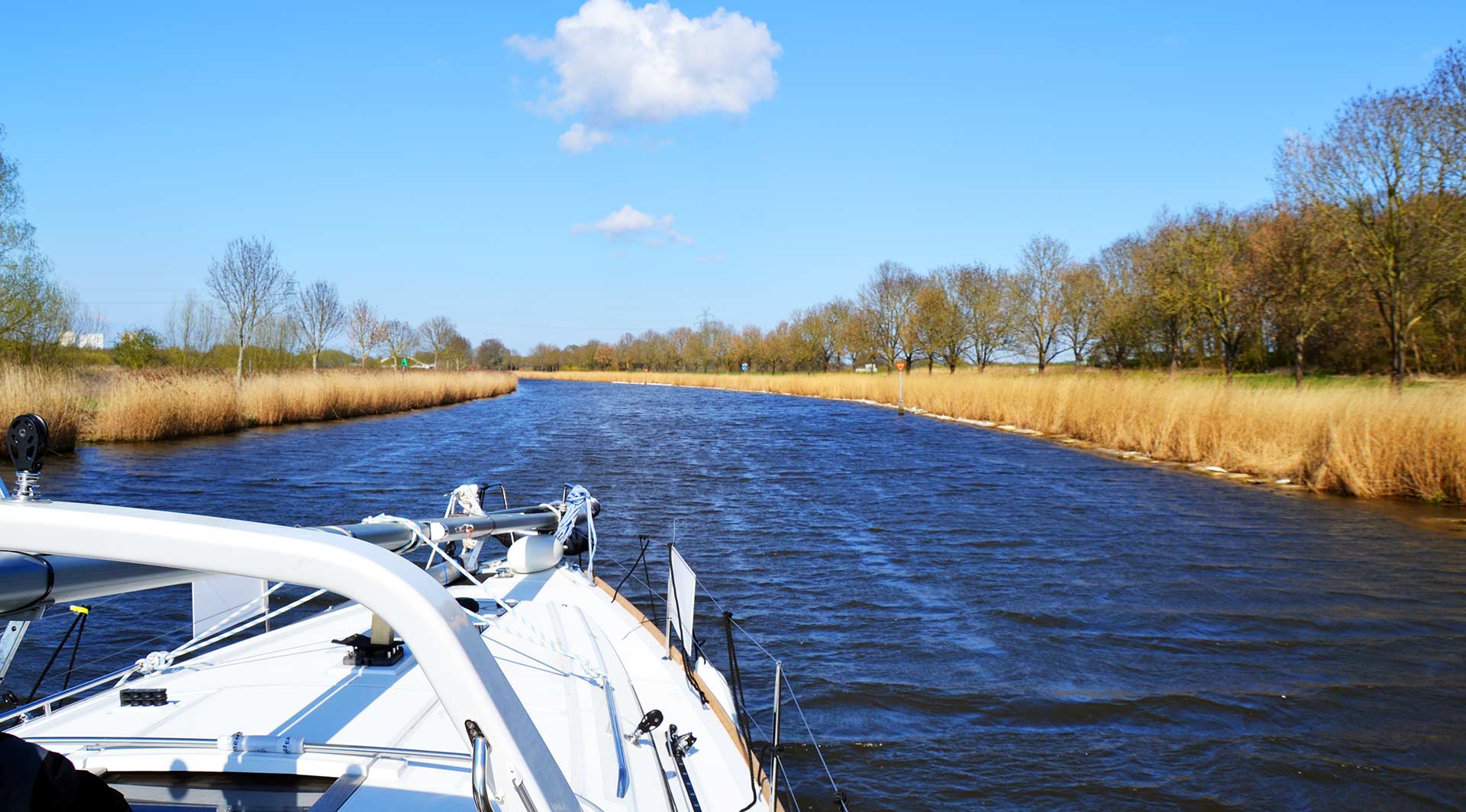
We are coming nearer to the Baltic Sea and we noticed this strongly. The Elbe-Luebeck-Canal bears no less than six (!) locks. Having passed one lock doesn´t take too much time for reaching the next. So when we changed the watch, the watch below didn´t get out of the clothing because it was inevitable that some 30 minutes later I called “lock ahead, come up!”.
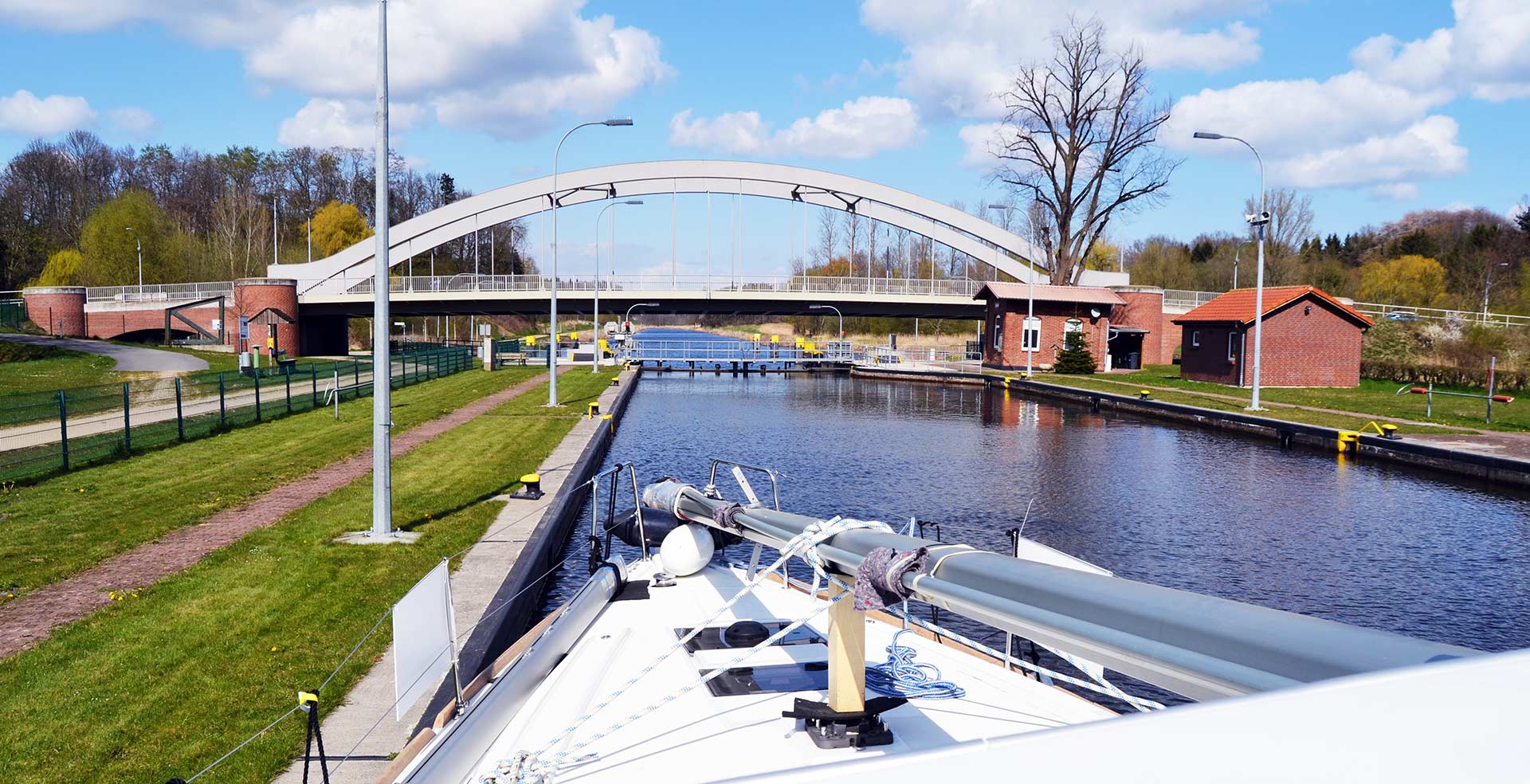
But the best news about these locks is: They are always on “green”. That goes as follows: Upon entering and passing the first lock, the master will call the next and notify the lock of our coming. So, presumed there is no traffic and no jam (which is happening during summer time) you don´t have to call up the locks one by the other but simply go there. When I approached, each and every lock was open and the light on green so that we didn´t had to wait a single minute. Great service though! By the way, it´s a known secret that river police uses the time taken between the locks to catch all-too fast skippers …
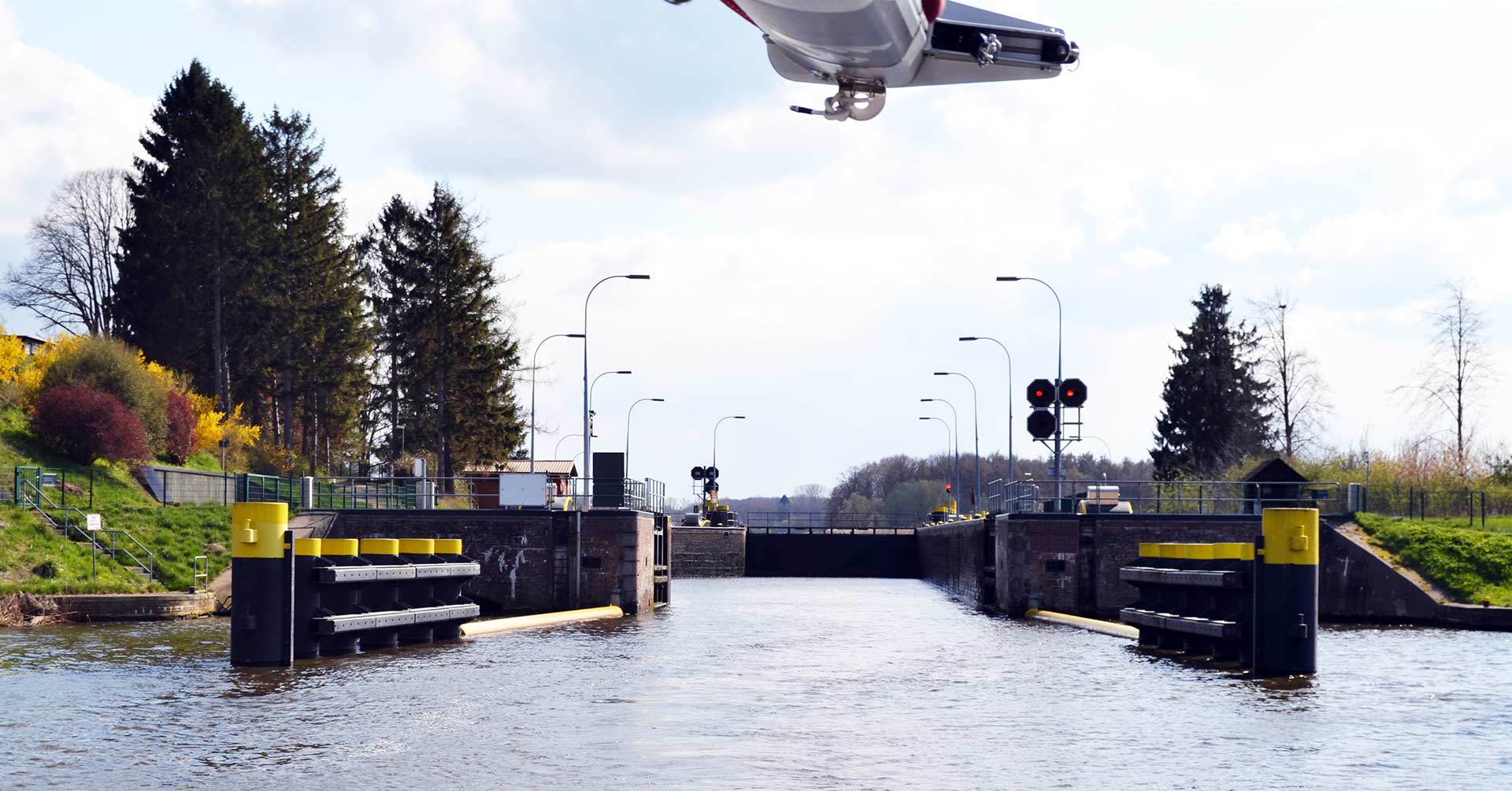
Locking process is always very easy as the altitude difference between “up” and “down” in each of them locks is not more than 2 to 4 metres, so you simply put the lines of the bollard and veer them by going down. In one of the last locks I had an adventure of a very special kind …
Adventure Intermezzo
Standing on the steering post and concentrating on the approach to the open lock, I suddenly heard somebody to my right hollering at me: “Hey there, I am in distress!” I looked, saw nothing. Then again: “Hey there, I am in distress! Help!” And there he was: A small motor vessel, makeshift-tied to a rusty barge. A man was sticking out of the small cabin, waving at me. I slowed down and he told me that his engine failed. “I need you to help me!” I know, it wasn´t the brightest of my moments, but still puzzled my brain found nothing more stupid to answer than: “I have children aboard!”
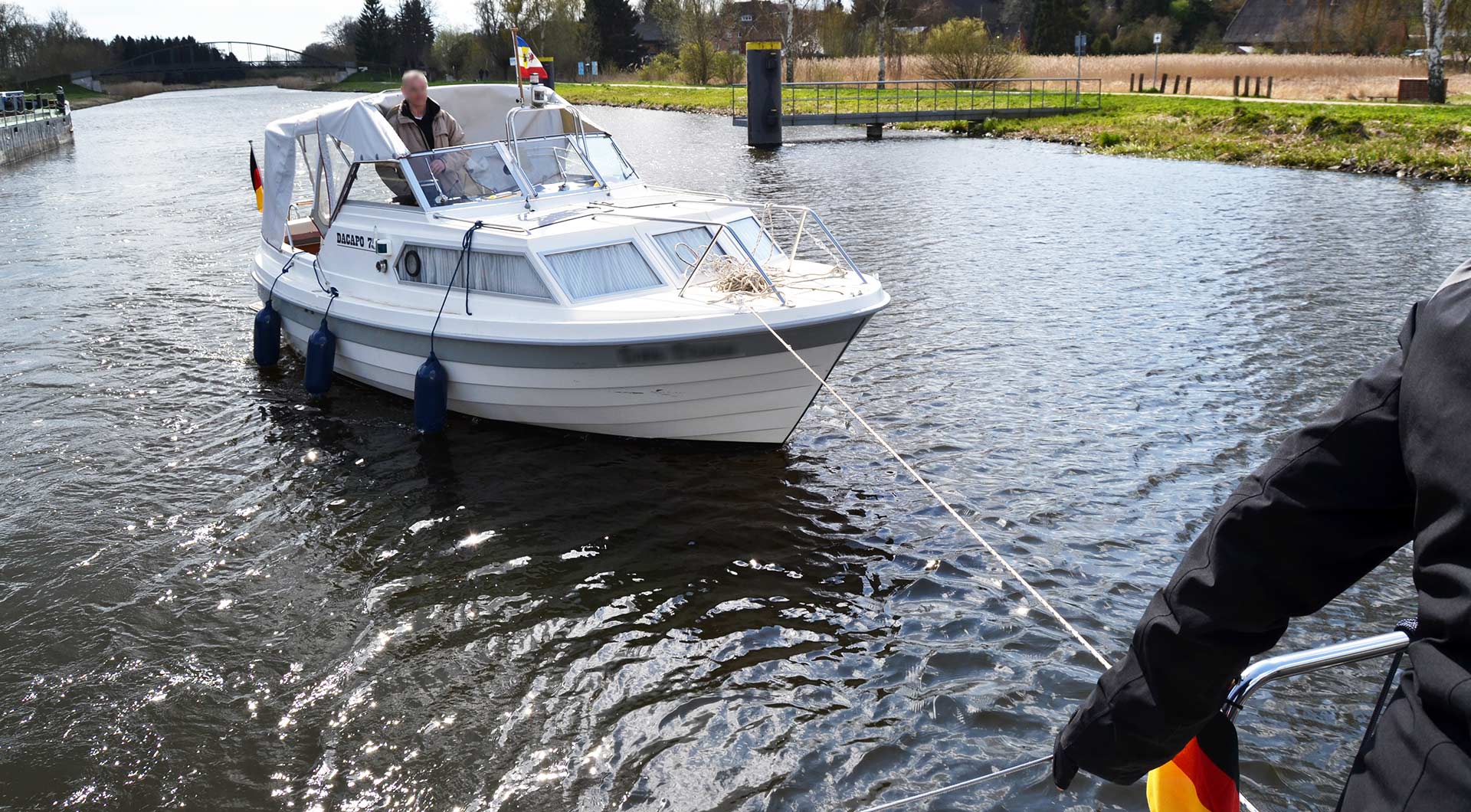
Well, that said I of course stopped, went alongside the barge as well and took over a towing line. He asked for towing to the other side of the canal where the barracks of the lock-maintenance was located and already one mechanic was standing by. So I accelerated to 5 knots and we let go the line, wishing him all the best.
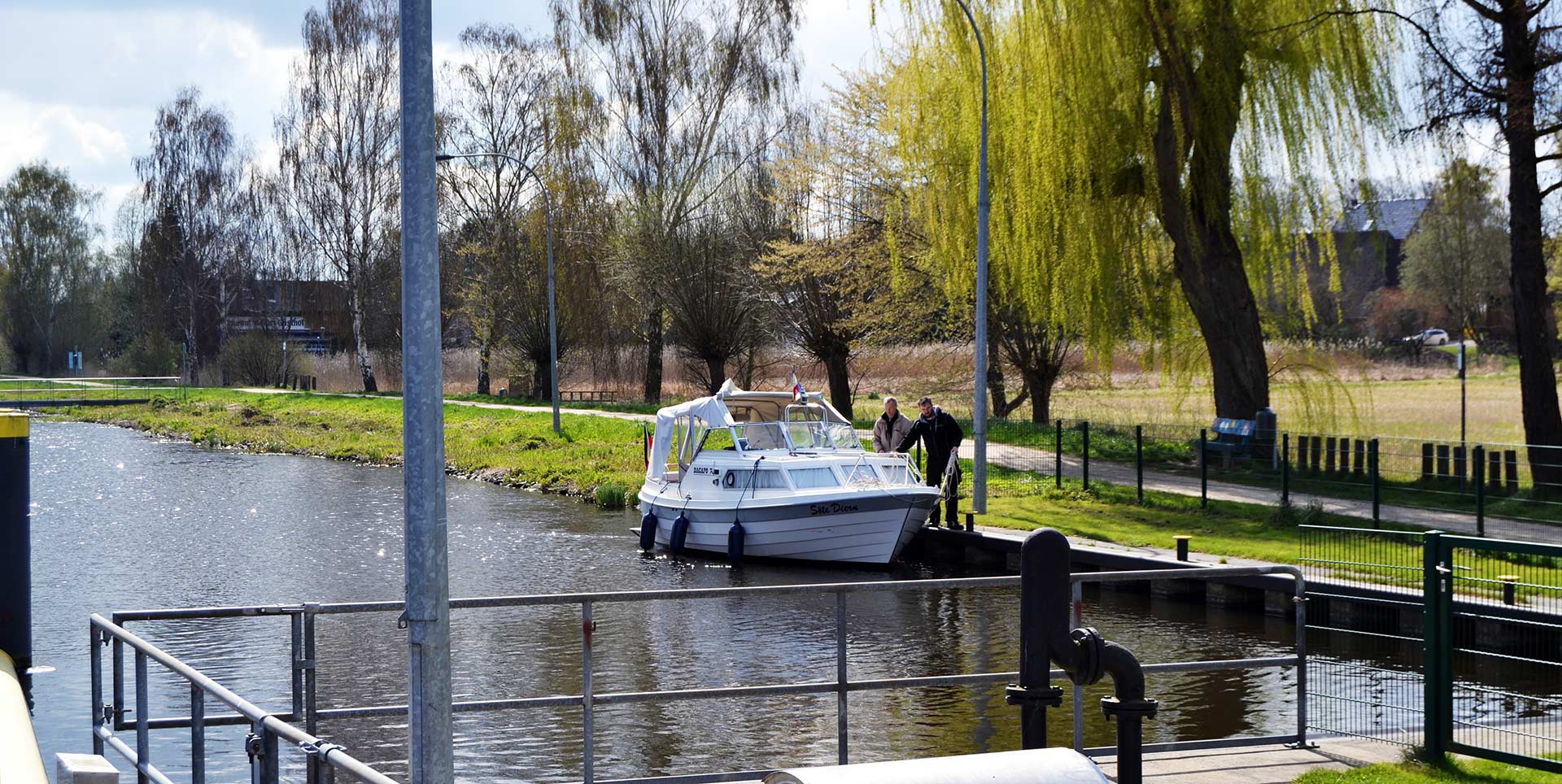
The momentum generated was sufficient enough to have him transported to the other side. I hope he could repair his small boat and get underway quickly. Apart from the brain-dropout when this all started I was kind of proud of our little rescue manoeuvre as it was done quickly, precisely and had a good outcome. So, after that last lock it was a no-brainer for our boat to race down the ever winding canal when the first spires of Luebeck´s famous churches could be seen over the tree tops. We were nearly there!
Luebeck in sight!
I moved to Luebeck some 2 years ago and despite the fact that this is a fantastic town with a very, very high quality of living it is my new home. So watching the distinct skyline of this old city growing bigger and bigger had quite an emotional effect on me as well: I was home, finally! The good crew of the Oceanis 35.1 and I myself brought this boat safely all the way up here and you know about this deep satisfaction that comes up in a sailor when he lands a boat safely. I felt so happy!
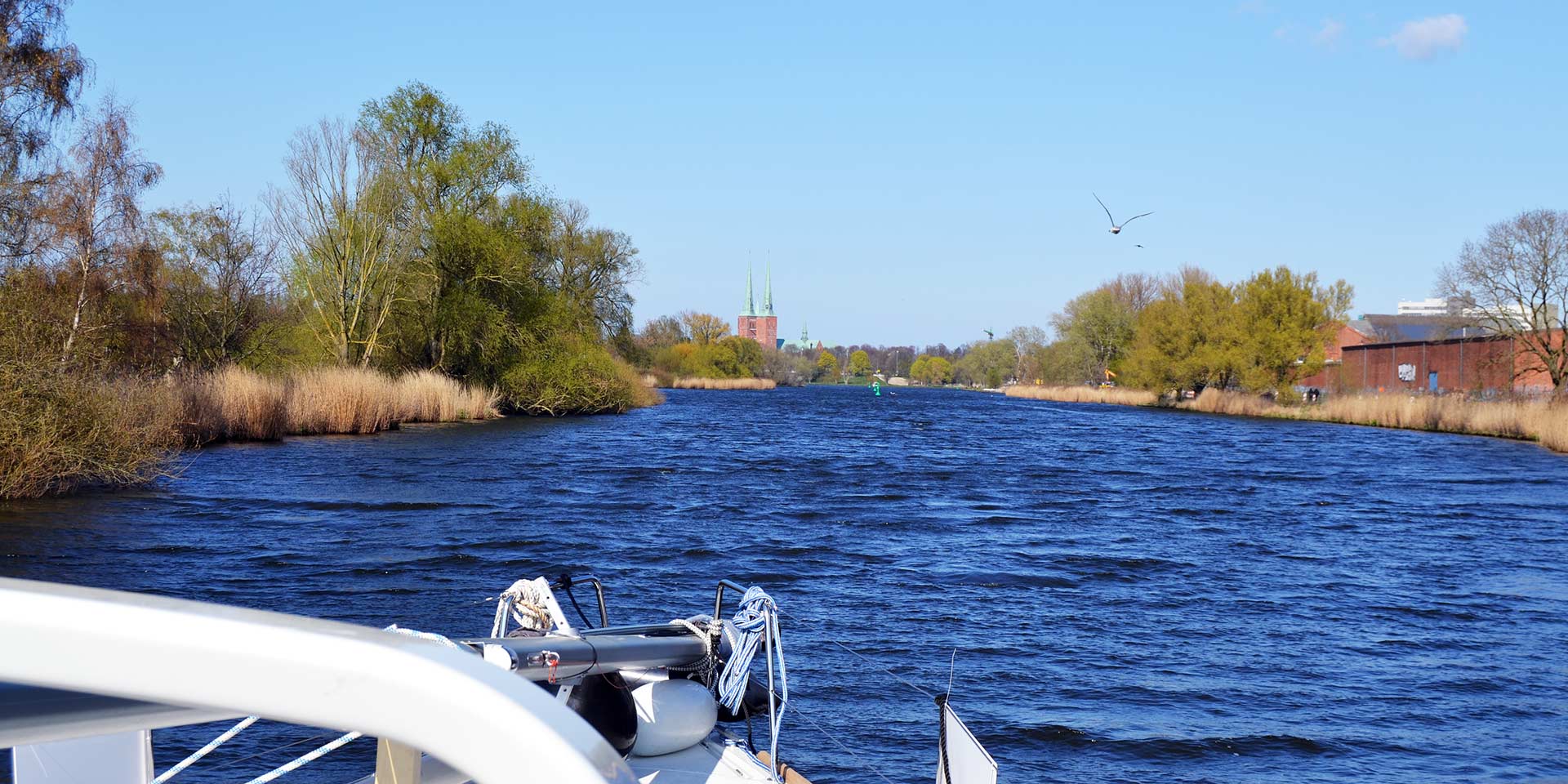
Luebeck is an old city that used to be the origin and center of the almighty German Hanse that was ruling Northern Europe for almost 500 years. The history of Luebeck is so rich, so exciting that it would take several articles for me to explain. You should come and have a visit here, it is definitely worth a trip. Luebeck was war more important than Hamburg and, luckily, when the German Hanse went down it wasn´t subdued to too many changes. It kept the medieval character.
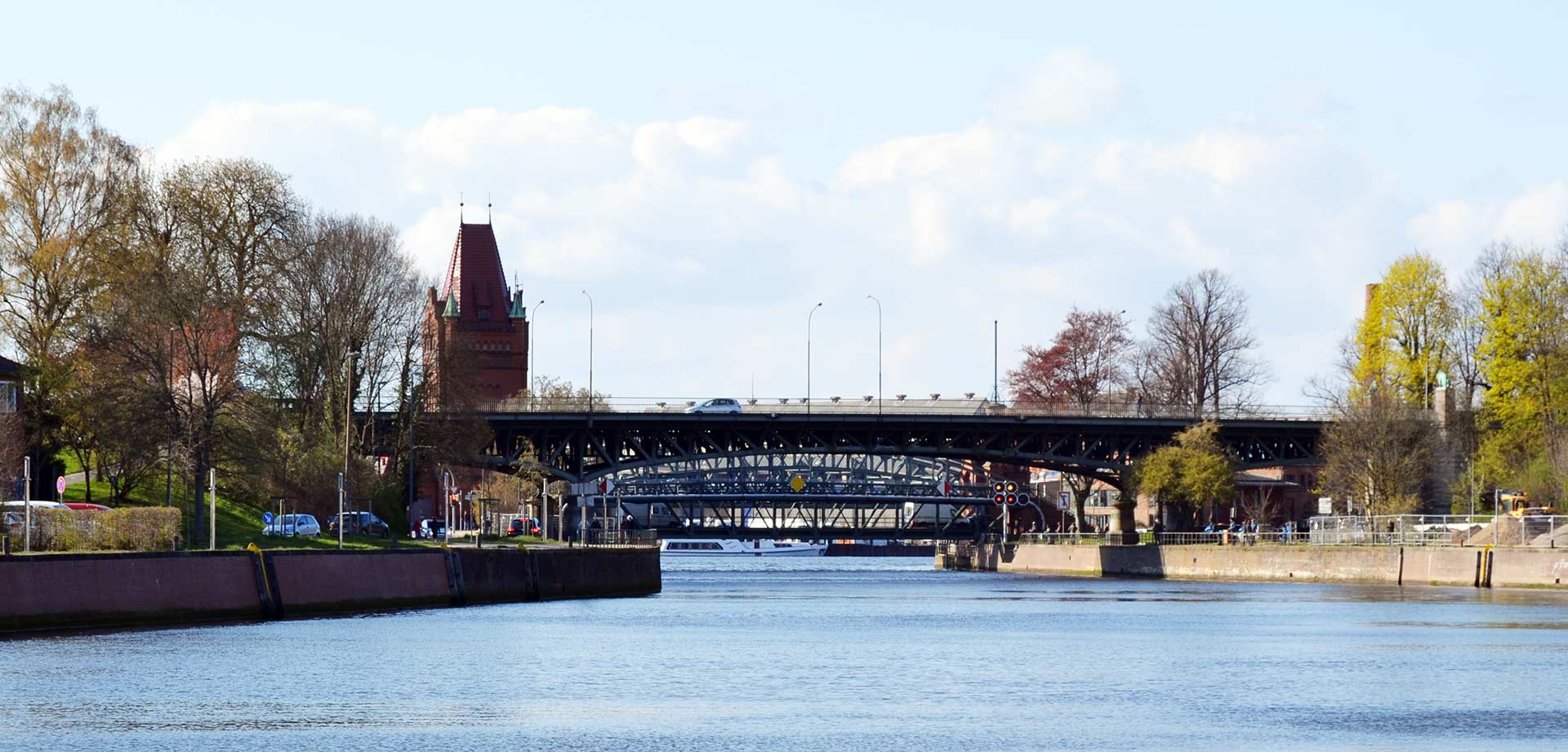
We approached the city of which the old city centre is situated on an island, completely surrounded by the River Trave. With barely 5 knots we steamed all alongside the old fortifications, lush green parks, remainders of the old town wall and passed some bridges. It was fiercely blowing a cold strong Northerly in my face, but I was so happy: Up until now we´ve made 147 miles inshore during this second leg starting in Hannover, all in all it had been 245 miles up to this day. We successfully passed 9 locks and one giant ship´s lift and had the engine up and running for 46 hours now.
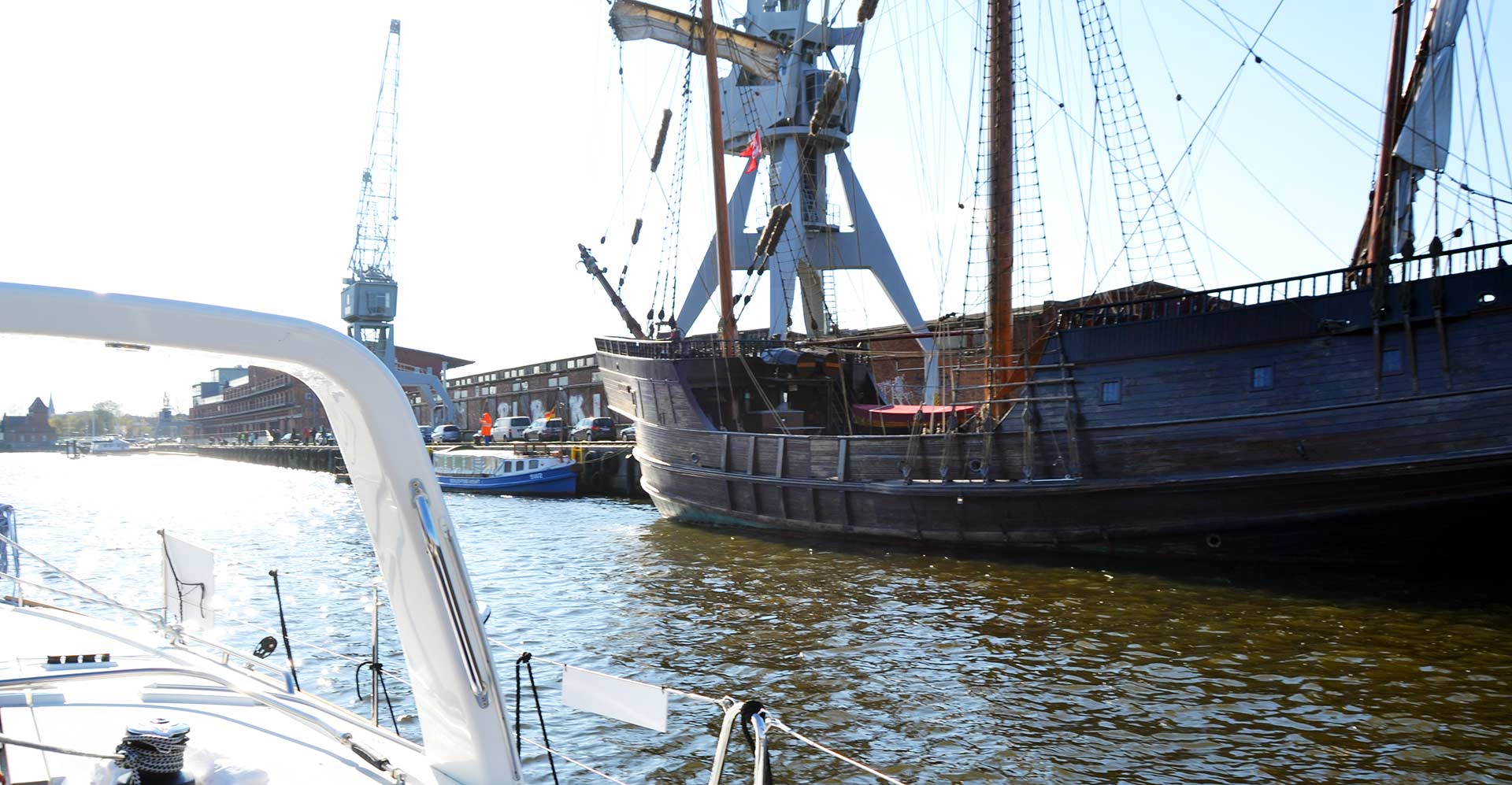
I steered passing the old Cog ship of Luebeck, which was built some years ago as a program for unemployed has become one of the big highlights of the old Luebeck harbour. This ship (read an article on this fascinating replica here) has generated a dozen or so permanent jobs and is actively sailing the Baltic Sea. I chose the newly build “Newport” Marina to land the boat and have the boat tied up for now.
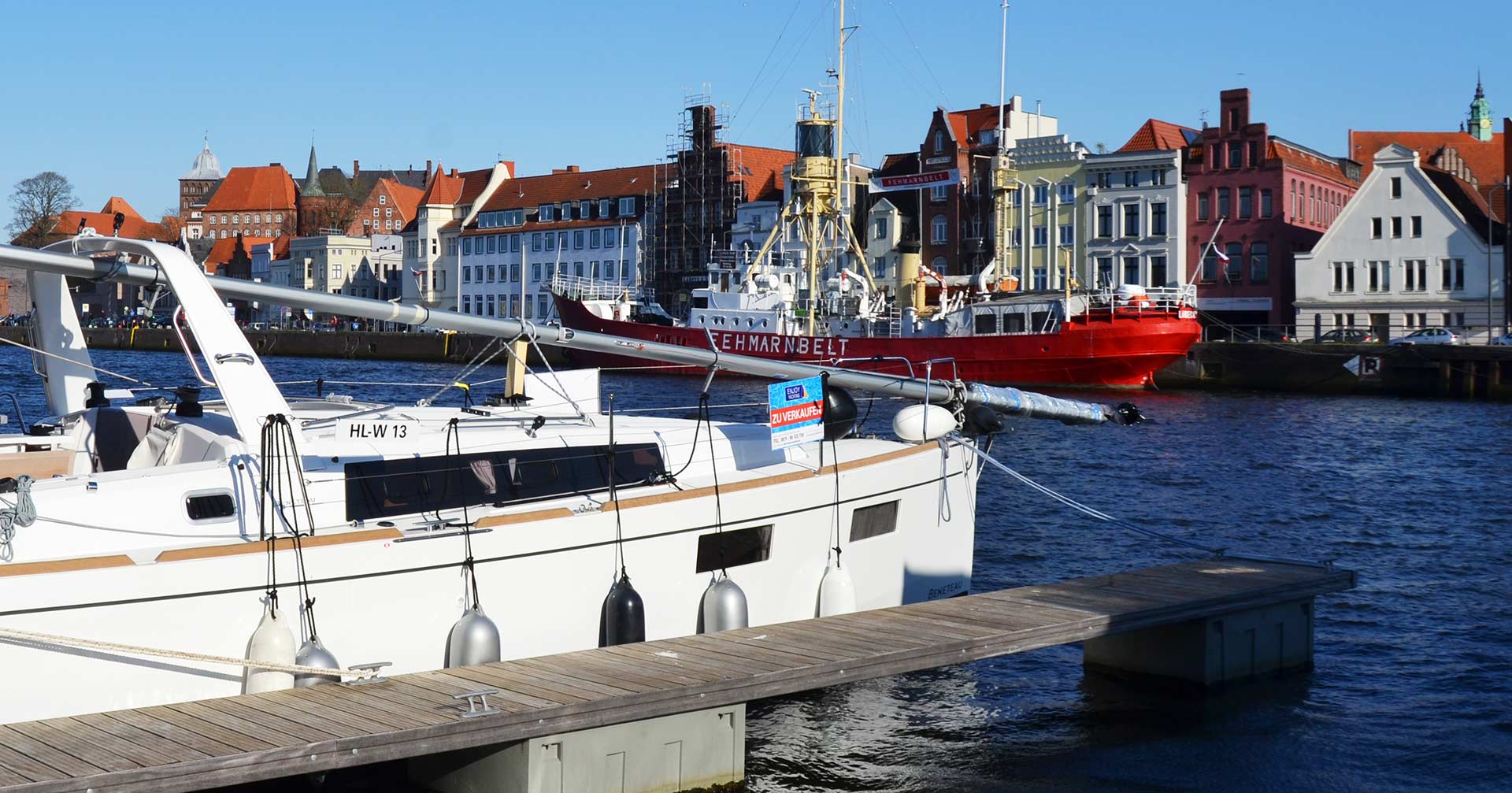
What a fantastic 4-day-journey that was! Two days later we brought the Oceanis to a nearby wharf where the rigging was stepped and the boat was fitted for sailing. This third and last leg is something for Part 3 of my inshore delivery-series – this time with white canvas up and in the wind and the boat doing what is was built to do for: Sailing, propelled by the power of Rasmus.
You may read all related articles by clicking on the hashtag #inshoredelivery
As well interesting:
Negotiating a bristling harbour at night
Old fashioned sailing trip planning
